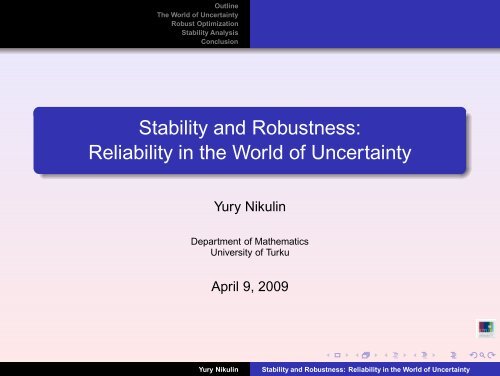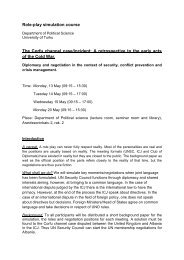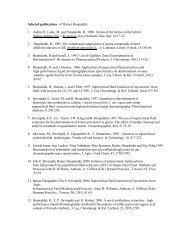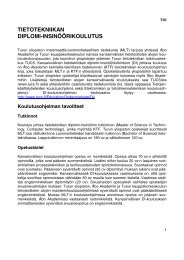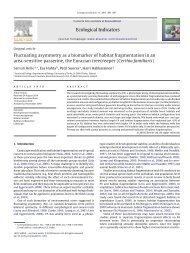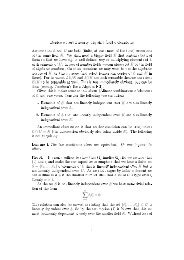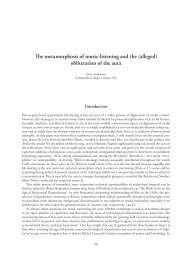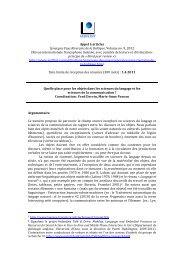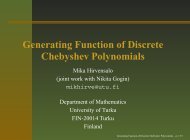Stability and Robustness: Reliability in the World of Uncertainty
Stability and Robustness: Reliability in the World of Uncertainty
Stability and Robustness: Reliability in the World of Uncertainty
You also want an ePaper? Increase the reach of your titles
YUMPU automatically turns print PDFs into web optimized ePapers that Google loves.
Outl<strong>in</strong>eThe <strong>World</strong> <strong>of</strong> Uncerta<strong>in</strong>tyRobust Optimization<strong>Stability</strong> AnalysisConclusion<strong>Stability</strong> <strong>and</strong> <strong>Robustness</strong>:<strong>Reliability</strong> <strong>in</strong> <strong>the</strong> <strong>World</strong> <strong>of</strong> Uncerta<strong>in</strong>tyYury Nikul<strong>in</strong>Department <strong>of</strong> Ma<strong>the</strong>maticsUniversity <strong>of</strong> TurkuApril 9, 2009Yury Nikul<strong>in</strong><strong>Stability</strong> <strong>and</strong> <strong>Robustness</strong>: <strong>Reliability</strong> <strong>in</strong> <strong>the</strong> <strong>World</strong> <strong>of</strong> Uncerta<strong>in</strong>ty
Outl<strong>in</strong>eOutl<strong>in</strong>eThe <strong>World</strong> <strong>of</strong> Uncerta<strong>in</strong>tyRobust Optimization<strong>Stability</strong> AnalysisConclusion1 The <strong>World</strong> <strong>of</strong> Uncerta<strong>in</strong>tyReasons for Uncerta<strong>in</strong>tyExtreme Consequences <strong>of</strong> Uncerta<strong>in</strong>tyEfficient Use <strong>of</strong> Uncerta<strong>in</strong>tyModel<strong>in</strong>g Uncerta<strong>in</strong>ty2 Robust Optimization3 <strong>Stability</strong> Analysis4 ConclusionYury Nikul<strong>in</strong><strong>Stability</strong> <strong>and</strong> <strong>Robustness</strong>: <strong>Reliability</strong> <strong>in</strong> <strong>the</strong> <strong>World</strong> <strong>of</strong> Uncerta<strong>in</strong>ty
Outl<strong>in</strong>eOutl<strong>in</strong>eThe <strong>World</strong> <strong>of</strong> Uncerta<strong>in</strong>tyRobust Optimization<strong>Stability</strong> AnalysisConclusionReasons for Uncerta<strong>in</strong>tyExtreme Consequences <strong>of</strong> Uncerta<strong>in</strong>tyEfficient Use <strong>of</strong> Uncerta<strong>in</strong>tyModel<strong>in</strong>g Uncerta<strong>in</strong>ty1 The <strong>World</strong> <strong>of</strong> Uncerta<strong>in</strong>tyReasons for Uncerta<strong>in</strong>tyExtreme Consequences <strong>of</strong> Uncerta<strong>in</strong>tyEfficient Use <strong>of</strong> Uncerta<strong>in</strong>tyModel<strong>in</strong>g Uncerta<strong>in</strong>ty2 Robust Optimization3 <strong>Stability</strong> Analysis4 ConclusionYury Nikul<strong>in</strong><strong>Stability</strong> <strong>and</strong> <strong>Robustness</strong>: <strong>Reliability</strong> <strong>in</strong> <strong>the</strong> <strong>World</strong> <strong>of</strong> Uncerta<strong>in</strong>ty
EpigraphOutl<strong>in</strong>eThe <strong>World</strong> <strong>of</strong> Uncerta<strong>in</strong>tyRobust Optimization<strong>Stability</strong> AnalysisConclusionReasons for Uncerta<strong>in</strong>tyExtreme Consequences <strong>of</strong> Uncerta<strong>in</strong>tyEfficient Use <strong>of</strong> Uncerta<strong>in</strong>tyModel<strong>in</strong>g Uncerta<strong>in</strong>tyButterfly effect... Superfluous one tenth degree <strong>in</strong> somepo<strong>in</strong>t – <strong>and</strong> a cyclone bursts out here <strong>in</strong>stead<strong>of</strong> <strong>the</strong>re, it storms over countries which wouldbe spared if it were not this tenth...... We f<strong>in</strong>d here aga<strong>in</strong> <strong>the</strong> same discrepancybetween a smallest reason which is notsensed by an observer, <strong>and</strong> a significanteffect caus<strong>in</strong>g sometimes terribleconsequences...Jules Henri Po<strong>in</strong>caré. The science <strong>and</strong> <strong>the</strong>method. 1908. Paris.Yury Nikul<strong>in</strong><strong>Stability</strong> <strong>and</strong> <strong>Robustness</strong>: <strong>Reliability</strong> <strong>in</strong> <strong>the</strong> <strong>World</strong> <strong>of</strong> Uncerta<strong>in</strong>ty
Outl<strong>in</strong>eThe <strong>World</strong> <strong>of</strong> Uncerta<strong>in</strong>tyRobust Optimization<strong>Stability</strong> AnalysisConclusionReasons for Uncerta<strong>in</strong>tyReasons for Uncerta<strong>in</strong>tyExtreme Consequences <strong>of</strong> Uncerta<strong>in</strong>tyEfficient Use <strong>of</strong> Uncerta<strong>in</strong>tyModel<strong>in</strong>g Uncerta<strong>in</strong>tyUncerta<strong>in</strong>ty <strong>in</strong> Optimization<strong>in</strong>accuracy <strong>of</strong> <strong>in</strong>itial datanon-adequacy <strong>of</strong> models to real processeserrors <strong>of</strong> numerical methodserrors <strong>of</strong> round<strong>in</strong>g <strong>of</strong>fabsence or lack <strong>of</strong> precise <strong>and</strong> reliable <strong>in</strong>formation etc.Yury Nikul<strong>in</strong><strong>Stability</strong> <strong>and</strong> <strong>Robustness</strong>: <strong>Reliability</strong> <strong>in</strong> <strong>the</strong> <strong>World</strong> <strong>of</strong> Uncerta<strong>in</strong>ty
Outl<strong>in</strong>eThe <strong>World</strong> <strong>of</strong> Uncerta<strong>in</strong>tyRobust Optimization<strong>Stability</strong> AnalysisConclusionReasons for Uncerta<strong>in</strong>tyReasons for Uncerta<strong>in</strong>tyExtreme Consequences <strong>of</strong> Uncerta<strong>in</strong>tyEfficient Use <strong>of</strong> Uncerta<strong>in</strong>tyModel<strong>in</strong>g Uncerta<strong>in</strong>tyUncerta<strong>in</strong>ty <strong>in</strong> Schedul<strong>in</strong>g <strong>and</strong> Time-tabl<strong>in</strong>gequipment (mach<strong>in</strong>e) breakdowns or activity (job) disruptionearl<strong>in</strong>ess or tard<strong>in</strong>ess, changes <strong>of</strong> job process<strong>in</strong>gchanges <strong>of</strong> release dates, due dates, deadl<strong>in</strong>es or resourceavailability etc.Yury Nikul<strong>in</strong><strong>Stability</strong> <strong>and</strong> <strong>Robustness</strong>: <strong>Reliability</strong> <strong>in</strong> <strong>the</strong> <strong>World</strong> <strong>of</strong> Uncerta<strong>in</strong>ty
Outl<strong>in</strong>eThe <strong>World</strong> <strong>of</strong> Uncerta<strong>in</strong>tyRobust Optimization<strong>Stability</strong> AnalysisConclusionReasons for Uncerta<strong>in</strong>tyExtreme Consequences <strong>of</strong> Uncerta<strong>in</strong>tyEfficient Use <strong>of</strong> Uncerta<strong>in</strong>tyModel<strong>in</strong>g Uncerta<strong>in</strong>tyExtreme Consequences <strong>of</strong> Uncerta<strong>in</strong>tySelf-Propagated Cha<strong>in</strong> Reactionsnuclear cha<strong>in</strong> reactiondom<strong>in</strong>o effectbutterfly effect<strong>the</strong>rmal runawaycascad<strong>in</strong>g failureelectron avalancheYury Nikul<strong>in</strong><strong>Stability</strong> <strong>and</strong> <strong>Robustness</strong>: <strong>Reliability</strong> <strong>in</strong> <strong>the</strong> <strong>World</strong> <strong>of</strong> Uncerta<strong>in</strong>ty
Outl<strong>in</strong>eThe <strong>World</strong> <strong>of</strong> Uncerta<strong>in</strong>tyRobust Optimization<strong>Stability</strong> AnalysisConclusionReasons for Uncerta<strong>in</strong>tyExtreme Consequences <strong>of</strong> Uncerta<strong>in</strong>tyEfficient Use <strong>of</strong> Uncerta<strong>in</strong>tyModel<strong>in</strong>g Uncerta<strong>in</strong>ty<strong>World</strong> Economic Crisis: Dom<strong>in</strong>o Effect1. PessimisticAccountReportPr<strong>of</strong>it10%downTransfer100billiondollarsattemporarydisposalPurchaseshares<strong>of</strong><strong>the</strong>GasProduc<strong>in</strong>gCompany100<strong>World</strong>EconomicCrisisasanexample<strong>of</strong><strong>the</strong>Dom<strong>in</strong>oEffectsGasProduc<strong>in</strong>gCompanyBankDeposit100GlobalF<strong>in</strong>ancialService1004. DepositWithdrawGett<strong>in</strong>g75b.d.tobuysharesPensionFund3. Sell<strong>in</strong>gsharesonlowerprices.Gett<strong>in</strong>g75b.d.Deficit15b.d.CommercialBankBuy<strong>in</strong>gfixedcostshares5. Sell<strong>in</strong>g2. Withdrawmoney90billiondollars.Lost10b.d.CommercialEnterprise5050shares.Gett<strong>in</strong>g50b.dDeficit25b.d.LongtermcreditIndustrialEnterpriseGovernment25+15=40b.d.RescuebailoutAverytemporarymeasuretosecure<strong>the</strong>f<strong>in</strong>ancialmarketplayers<strong>and</strong>overcomeliquiditydeficit.O<strong>the</strong>rwise,badlongtermconsequences:f<strong>in</strong>ancialsectorcollapse,<strong>in</strong>dustrialsectorslowsdown,unemploymentgrows,economicfalls<strong>in</strong>torecession“Hid<strong>in</strong>ganelephantbeh<strong>in</strong>damouse!”Yury Nikul<strong>in</strong><strong>Stability</strong> <strong>and</strong> <strong>Robustness</strong>: <strong>Reliability</strong> <strong>in</strong> <strong>the</strong> <strong>World</strong> <strong>of</strong> Uncerta<strong>in</strong>ty
Outl<strong>in</strong>eThe <strong>World</strong> <strong>of</strong> Uncerta<strong>in</strong>tyRobust Optimization<strong>Stability</strong> AnalysisConclusionReasons for Uncerta<strong>in</strong>tyExtreme Consequences <strong>of</strong> Uncerta<strong>in</strong>tyEfficient Use <strong>of</strong> Uncerta<strong>in</strong>tyModel<strong>in</strong>g Uncerta<strong>in</strong>tyIf only be<strong>in</strong>g predicted <strong>and</strong> controlleduncerta<strong>in</strong>ty may pr<strong>of</strong>it!Complicated system + artificially caused uncerta<strong>in</strong>ty ↦→ systemnon-stability ↦→ controlled to some extent cha<strong>in</strong> reactions ↦→ systembe<strong>in</strong>g changed ↦→ diversification, selection or separation ↦→measur<strong>in</strong>g new data <strong>and</strong> gett<strong>in</strong>g <strong>the</strong> result.Yury Nikul<strong>in</strong><strong>Stability</strong> <strong>and</strong> <strong>Robustness</strong>: <strong>Reliability</strong> <strong>in</strong> <strong>the</strong> <strong>World</strong> <strong>of</strong> Uncerta<strong>in</strong>ty
Outl<strong>in</strong>eThe <strong>World</strong> <strong>of</strong> Uncerta<strong>in</strong>tyRobust Optimization<strong>Stability</strong> AnalysisConclusionReasons for Uncerta<strong>in</strong>tyExtreme Consequences <strong>of</strong> Uncerta<strong>in</strong>tyEfficient Use <strong>of</strong> Uncerta<strong>in</strong>tyModel<strong>in</strong>g Uncerta<strong>in</strong>tyFrom Microwave Heat<strong>in</strong>g to Electron Collid<strong>in</strong>gThermal runaway used <strong>in</strong> microwave heat<strong>in</strong>gMicrowaves + materials ↦→ energyabsorption ↦→ materials heat<strong>in</strong>g ↦→ controlled<strong>the</strong>rmal runaway ↦→ selective localoverheat<strong>in</strong>g ↦→ material separation based ontemperature.Yury Nikul<strong>in</strong><strong>Stability</strong> <strong>and</strong> <strong>Robustness</strong>: <strong>Reliability</strong> <strong>in</strong> <strong>the</strong> <strong>World</strong> <strong>of</strong> Uncerta<strong>in</strong>ty
Outl<strong>in</strong>eThe <strong>World</strong> <strong>of</strong> Uncerta<strong>in</strong>tyRobust Optimization<strong>Stability</strong> AnalysisConclusionReasons for Uncerta<strong>in</strong>tyExtreme Consequences <strong>of</strong> Uncerta<strong>in</strong>tyEfficient Use <strong>of</strong> Uncerta<strong>in</strong>tyModel<strong>in</strong>g Uncerta<strong>in</strong>tyFrom Microwave Heat<strong>in</strong>g to Electron Collid<strong>in</strong>gProton avalanche used <strong>in</strong> Large Hadron ColliderThe Large Hadron Collider (LHC) is <strong>the</strong> world’slargest <strong>and</strong> highest-energy particle acceleratorcomplex, <strong>in</strong>tended to collide oppos<strong>in</strong>g beams <strong>of</strong>protons with very high k<strong>in</strong>etic energy (8 billiondollars, 14 years, 40 countries)GoalsTo confirm <strong>the</strong> Big Bang <strong>the</strong>oryTo unveil <strong>the</strong> secrets <strong>of</strong> dark matterTo get more knowledge about mass <strong>and</strong>gravityYury Nikul<strong>in</strong><strong>Stability</strong> <strong>and</strong> <strong>Robustness</strong>: <strong>Reliability</strong> <strong>in</strong> <strong>the</strong> <strong>World</strong> <strong>of</strong> Uncerta<strong>in</strong>ty
Outl<strong>in</strong>eThe <strong>World</strong> <strong>of</strong> Uncerta<strong>in</strong>tyRobust Optimization<strong>Stability</strong> AnalysisConclusionModel<strong>in</strong>g Uncerta<strong>in</strong>tyReasons for Uncerta<strong>in</strong>tyExtreme Consequences <strong>of</strong> Uncerta<strong>in</strong>tyEfficient Use <strong>of</strong> Uncerta<strong>in</strong>tyModel<strong>in</strong>g Uncerta<strong>in</strong>tyUncerta<strong>in</strong>ty can be modeled by means <strong>of</strong>:possible scenarios (parameter realizations)fuzzy numbers <strong>and</strong> fuzzy objective functionsvarious probabilistic measures<strong>in</strong>terval dataYury Nikul<strong>in</strong><strong>Stability</strong> <strong>and</strong> <strong>Robustness</strong>: <strong>Reliability</strong> <strong>in</strong> <strong>the</strong> <strong>World</strong> <strong>of</strong> Uncerta<strong>in</strong>ty
Interval Uncerta<strong>in</strong>tyOutl<strong>in</strong>eThe <strong>World</strong> <strong>of</strong> Uncerta<strong>in</strong>tyRobust Optimization<strong>Stability</strong> AnalysisConclusionReasons for Uncerta<strong>in</strong>tyExtreme Consequences <strong>of</strong> Uncerta<strong>in</strong>tyEfficient Use <strong>of</strong> Uncerta<strong>in</strong>tyModel<strong>in</strong>g Uncerta<strong>in</strong>tyAdvantagesLower <strong>and</strong> upper <strong>in</strong>terval bounds are easy to specifyNo statistical observations needed for <strong>the</strong> modelEasy implementation <strong>and</strong> practical useDisadvantagesInf<strong>in</strong>ite number <strong>of</strong> problem <strong>in</strong>put parameter realization -scenarios (can be overcome for some models!)Yury Nikul<strong>in</strong><strong>Stability</strong> <strong>and</strong> <strong>Robustness</strong>: <strong>Reliability</strong> <strong>in</strong> <strong>the</strong> <strong>World</strong> <strong>of</strong> Uncerta<strong>in</strong>ty
Interval Uncerta<strong>in</strong>tyOutl<strong>in</strong>eThe <strong>World</strong> <strong>of</strong> Uncerta<strong>in</strong>tyRobust Optimization<strong>Stability</strong> AnalysisConclusionReasons for Uncerta<strong>in</strong>tyExtreme Consequences <strong>of</strong> Uncerta<strong>in</strong>tyEfficient Use <strong>of</strong> Uncerta<strong>in</strong>tyModel<strong>in</strong>g Uncerta<strong>in</strong>tyAdvantagesLower <strong>and</strong> upper <strong>in</strong>terval bounds are easy to specifyNo statistical observations needed for <strong>the</strong> modelEasy implementation <strong>and</strong> practical useDisadvantagesInf<strong>in</strong>ite number <strong>of</strong> problem <strong>in</strong>put parameter realization -scenarios (can be overcome for some models!)Yury Nikul<strong>in</strong><strong>Stability</strong> <strong>and</strong> <strong>Robustness</strong>: <strong>Reliability</strong> <strong>in</strong> <strong>the</strong> <strong>World</strong> <strong>of</strong> Uncerta<strong>in</strong>ty
Outl<strong>in</strong>eOutl<strong>in</strong>eThe <strong>World</strong> <strong>of</strong> Uncerta<strong>in</strong>tyRobust Optimization<strong>Stability</strong> AnalysisConclusion1 The <strong>World</strong> <strong>of</strong> Uncerta<strong>in</strong>tyReasons for Uncerta<strong>in</strong>tyExtreme Consequences <strong>of</strong> Uncerta<strong>in</strong>tyEfficient Use <strong>of</strong> Uncerta<strong>in</strong>tyModel<strong>in</strong>g Uncerta<strong>in</strong>ty2 Robust Optimization3 <strong>Stability</strong> Analysis4 ConclusionYury Nikul<strong>in</strong><strong>Stability</strong> <strong>and</strong> <strong>Robustness</strong>: <strong>Reliability</strong> <strong>in</strong> <strong>the</strong> <strong>World</strong> <strong>of</strong> Uncerta<strong>in</strong>ty
Outl<strong>in</strong>eThe <strong>World</strong> <strong>of</strong> Uncerta<strong>in</strong>tyRobust Optimization<strong>Stability</strong> AnalysisConclusionWhat is Robust Optimization?Play<strong>in</strong>g aga<strong>in</strong>st <strong>the</strong> Worst-CaseInstead <strong>of</strong> produc<strong>in</strong>g an optimal solution for a normal situation, whichis described by determ<strong>in</strong>istic models but rarely occurs <strong>in</strong> practice, <strong>and</strong>where recovery to optimality can be complicated, <strong>the</strong> aim <strong>of</strong> robustoptimization is to produce solutions that optimize additionallyconstructed objectives assur<strong>in</strong>g <strong>the</strong> optimal solution to rema<strong>in</strong>feasible after worst case realization <strong>of</strong> uncerta<strong>in</strong> problem <strong>in</strong>putparameters.Yury Nikul<strong>in</strong><strong>Stability</strong> <strong>and</strong> <strong>Robustness</strong>: <strong>Reliability</strong> <strong>in</strong> <strong>the</strong> <strong>World</strong> <strong>of</strong> Uncerta<strong>in</strong>ty
Outl<strong>in</strong>eThe <strong>World</strong> <strong>of</strong> Uncerta<strong>in</strong>tyRobust Optimization<strong>Stability</strong> AnalysisConclusionWhat is a Robust Solution?Straightforward <strong>Robustness</strong>An optimal solution is robust if it rema<strong>in</strong>s optimal under anyrealization <strong>of</strong> <strong>the</strong> <strong>in</strong>put dataAbsolute <strong>Robustness</strong>A solution which m<strong>in</strong>imizes <strong>the</strong> maximum among all scenariosobjective valueRelative <strong>Robustness</strong>A solution which m<strong>in</strong>imizes <strong>the</strong> maximum regret or, among allscenarios, <strong>the</strong> maximum deviation from optimal solutionYury Nikul<strong>in</strong><strong>Stability</strong> <strong>and</strong> <strong>Robustness</strong>: <strong>Reliability</strong> <strong>in</strong> <strong>the</strong> <strong>World</strong> <strong>of</strong> Uncerta<strong>in</strong>ty
Outl<strong>in</strong>eThe <strong>World</strong> <strong>of</strong> Uncerta<strong>in</strong>tyRobust Optimization<strong>Stability</strong> AnalysisConclusionWhat is a Robust Solution?Straightforward <strong>Robustness</strong>An optimal solution is robust if it rema<strong>in</strong>s optimal under anyrealization <strong>of</strong> <strong>the</strong> <strong>in</strong>put dataAbsolute <strong>Robustness</strong>A solution which m<strong>in</strong>imizes <strong>the</strong> maximum among all scenariosobjective valueRelative <strong>Robustness</strong>A solution which m<strong>in</strong>imizes <strong>the</strong> maximum regret or, among allscenarios, <strong>the</strong> maximum deviation from optimal solutionYury Nikul<strong>in</strong><strong>Stability</strong> <strong>and</strong> <strong>Robustness</strong>: <strong>Reliability</strong> <strong>in</strong> <strong>the</strong> <strong>World</strong> <strong>of</strong> Uncerta<strong>in</strong>ty
Outl<strong>in</strong>eThe <strong>World</strong> <strong>of</strong> Uncerta<strong>in</strong>tyRobust Optimization<strong>Stability</strong> AnalysisConclusionWhat is a Robust Solution?Straightforward <strong>Robustness</strong>An optimal solution is robust if it rema<strong>in</strong>s optimal under anyrealization <strong>of</strong> <strong>the</strong> <strong>in</strong>put dataAbsolute <strong>Robustness</strong>A solution which m<strong>in</strong>imizes <strong>the</strong> maximum among all scenariosobjective valueRelative <strong>Robustness</strong>A solution which m<strong>in</strong>imizes <strong>the</strong> maximum regret or, among allscenarios, <strong>the</strong> maximum deviation from optimal solutionYury Nikul<strong>in</strong><strong>Stability</strong> <strong>and</strong> <strong>Robustness</strong>: <strong>Reliability</strong> <strong>in</strong> <strong>the</strong> <strong>World</strong> <strong>of</strong> Uncerta<strong>in</strong>ty
Outl<strong>in</strong>eThe <strong>World</strong> <strong>of</strong> Uncerta<strong>in</strong>tyRobust Optimization<strong>Stability</strong> AnalysisConclusionWhat is a Robust Solution?Straightforward <strong>Robustness</strong>An optimal solution is robust if it rema<strong>in</strong>s optimal under anyrealization <strong>of</strong> <strong>the</strong> <strong>in</strong>put dataAbsolute <strong>Robustness</strong>A solution which m<strong>in</strong>imizes <strong>the</strong> maximum among all scenariosobjective valueRelative <strong>Robustness</strong>A solution which m<strong>in</strong>imizes <strong>the</strong> maximum regret or, among allscenarios, <strong>the</strong> maximum deviation from optimal solutionYury Nikul<strong>in</strong><strong>Stability</strong> <strong>and</strong> <strong>Robustness</strong>: <strong>Reliability</strong> <strong>in</strong> <strong>the</strong> <strong>World</strong> <strong>of</strong> Uncerta<strong>in</strong>ty
Outl<strong>in</strong>eThe <strong>World</strong> <strong>of</strong> Uncerta<strong>in</strong>tyRobust Optimization<strong>Stability</strong> AnalysisConclusionThe Robust Spann<strong>in</strong>g Tree ProblemAssume that with each edge e = ij ∈ E we associate a cost <strong>in</strong>terval[l ij , u ij ], 0 < l ij < u ij , i.e. For each edge ij ∈ E its cost c ij is notfixed <strong>and</strong> belongs to [l ij , u ij ].The total cost c T <strong>of</strong> spann<strong>in</strong>g tree T ∈ T G is def<strong>in</strong>ed as:c T := ∑ij∈E Tc ij .A scenario s ∈ S is a particular realization <strong>of</strong> <strong>the</strong> edge costs taken<strong>the</strong>ir values from associated <strong>in</strong>tervals.Yury Nikul<strong>in</strong><strong>Stability</strong> <strong>and</strong> <strong>Robustness</strong>: <strong>Reliability</strong> <strong>in</strong> <strong>the</strong> <strong>World</strong> <strong>of</strong> Uncerta<strong>in</strong>ty
Outl<strong>in</strong>eThe <strong>World</strong> <strong>of</strong> Uncerta<strong>in</strong>tyRobust Optimization<strong>Stability</strong> AnalysisConclusionThe Robust Spann<strong>in</strong>g Tree ProblemAssume that with each edge e = ij ∈ E we associate a cost <strong>in</strong>terval[l ij , u ij ], 0 < l ij < u ij , i.e. For each edge ij ∈ E its cost c ij is notfixed <strong>and</strong> belongs to [l ij , u ij ].The total cost c T <strong>of</strong> spann<strong>in</strong>g tree T ∈ T G is def<strong>in</strong>ed as:c T := ∑ij∈E Tc ij .A scenario s ∈ S is a particular realization <strong>of</strong> <strong>the</strong> edge costs taken<strong>the</strong>ir values from associated <strong>in</strong>tervals.Yury Nikul<strong>in</strong><strong>Stability</strong> <strong>and</strong> <strong>Robustness</strong>: <strong>Reliability</strong> <strong>in</strong> <strong>the</strong> <strong>World</strong> <strong>of</strong> Uncerta<strong>in</strong>ty
Outl<strong>in</strong>eThe <strong>World</strong> <strong>of</strong> Uncerta<strong>in</strong>tyRobust Optimization<strong>Stability</strong> AnalysisConclusionThe Robust Spann<strong>in</strong>g Tree ProblemAssume that with each edge e = ij ∈ E we associate a cost <strong>in</strong>terval[l ij , u ij ], 0 < l ij < u ij , i.e. For each edge ij ∈ E its cost c ij is notfixed <strong>and</strong> belongs to [l ij , u ij ].The total cost c T <strong>of</strong> spann<strong>in</strong>g tree T ∈ T G is def<strong>in</strong>ed as:c T := ∑ij∈E Tc ij .A scenario s ∈ S is a particular realization <strong>of</strong> <strong>the</strong> edge costs taken<strong>the</strong>ir values from associated <strong>in</strong>tervals.Yury Nikul<strong>in</strong><strong>Stability</strong> <strong>and</strong> <strong>Robustness</strong>: <strong>Reliability</strong> <strong>in</strong> <strong>the</strong> <strong>World</strong> <strong>of</strong> Uncerta<strong>in</strong>ty
Outl<strong>in</strong>eThe <strong>World</strong> <strong>of</strong> Uncerta<strong>in</strong>tyRobust Optimization<strong>Stability</strong> AnalysisConclusionThe Robust Spann<strong>in</strong>g Tree ProblemAssume that with each edge e = ij ∈ E we associate a cost <strong>in</strong>terval[l ij , u ij ], 0 < l ij < u ij , i.e. For each edge ij ∈ E its cost c ij is notfixed <strong>and</strong> belongs to [l ij , u ij ].The total cost c T <strong>of</strong> spann<strong>in</strong>g tree T ∈ T G is def<strong>in</strong>ed as:c T := ∑ij∈E Tc ij .A scenario s ∈ S is a particular realization <strong>of</strong> <strong>the</strong> edge costs taken<strong>the</strong>ir values from associated <strong>in</strong>tervals.Yury Nikul<strong>in</strong><strong>Stability</strong> <strong>and</strong> <strong>Robustness</strong>: <strong>Reliability</strong> <strong>in</strong> <strong>the</strong> <strong>World</strong> <strong>of</strong> Uncerta<strong>in</strong>ty
Outl<strong>in</strong>eThe <strong>World</strong> <strong>of</strong> Uncerta<strong>in</strong>tyRobust Optimization<strong>Stability</strong> AnalysisConclusionThe Robust Spann<strong>in</strong>g Tree ProblemFor each spann<strong>in</strong>g tree T <strong>in</strong> scenario s <strong>the</strong> deviation for T <strong>in</strong> scenarios is def<strong>in</strong>ed as:dev s T := cs T − m<strong>in</strong>T ′ ∈T cs T ′.Let S be <strong>the</strong> set <strong>of</strong> all scenarios. For a given spann<strong>in</strong>g tree T ∈ T G<strong>the</strong> worst-case scenario s T is def<strong>in</strong>ed as:s T := arg maxs∈S devs T .Yury Nikul<strong>in</strong><strong>Stability</strong> <strong>and</strong> <strong>Robustness</strong>: <strong>Reliability</strong> <strong>in</strong> <strong>the</strong> <strong>World</strong> <strong>of</strong> Uncerta<strong>in</strong>ty
Outl<strong>in</strong>eThe <strong>World</strong> <strong>of</strong> Uncerta<strong>in</strong>tyRobust Optimization<strong>Stability</strong> AnalysisConclusionThe Robust Spann<strong>in</strong>g Tree ProblemFor each spann<strong>in</strong>g tree T <strong>in</strong> scenario s <strong>the</strong> deviation for T <strong>in</strong> scenarios is def<strong>in</strong>ed as:dev s T := cs T − m<strong>in</strong>T ′ ∈T cs T ′.Let S be <strong>the</strong> set <strong>of</strong> all scenarios. For a given spann<strong>in</strong>g tree T ∈ T G<strong>the</strong> worst-case scenario s T is def<strong>in</strong>ed as:s T := arg maxs∈S devs T .Yury Nikul<strong>in</strong><strong>Stability</strong> <strong>and</strong> <strong>Robustness</strong>: <strong>Reliability</strong> <strong>in</strong> <strong>the</strong> <strong>World</strong> <strong>of</strong> Uncerta<strong>in</strong>ty
Outl<strong>in</strong>eThe <strong>World</strong> <strong>of</strong> Uncerta<strong>in</strong>tyRobust Optimization<strong>Stability</strong> AnalysisConclusionThe Robust Spann<strong>in</strong>g Tree ProblemFor each spann<strong>in</strong>g tree T <strong>in</strong> scenario s <strong>the</strong> deviation for T <strong>in</strong> scenarios is def<strong>in</strong>ed as:dev s T := cs T − m<strong>in</strong>T ′ ∈T cs T ′.Let S be <strong>the</strong> set <strong>of</strong> all scenarios. For a given spann<strong>in</strong>g tree T ∈ T G<strong>the</strong> worst-case scenario s T is def<strong>in</strong>ed as:s T := arg maxs∈S devs T .Yury Nikul<strong>in</strong><strong>Stability</strong> <strong>and</strong> <strong>Robustness</strong>: <strong>Reliability</strong> <strong>in</strong> <strong>the</strong> <strong>World</strong> <strong>of</strong> Uncerta<strong>in</strong>ty
Outl<strong>in</strong>eThe <strong>World</strong> <strong>of</strong> Uncerta<strong>in</strong>tyRobust Optimization<strong>Stability</strong> AnalysisConclusionThe Robust Spann<strong>in</strong>g Tree ProblemFor each spann<strong>in</strong>g tree T <strong>in</strong> scenario s <strong>the</strong> deviation for T <strong>in</strong> scenarios is def<strong>in</strong>ed as:dev s T := cs T − m<strong>in</strong>T ′ ∈T cs T ′.Let S be <strong>the</strong> set <strong>of</strong> all scenarios. For a given spann<strong>in</strong>g tree T ∈ T G<strong>the</strong> worst-case scenario s T is def<strong>in</strong>ed as:s T := arg maxs∈S devs T .Yury Nikul<strong>in</strong><strong>Stability</strong> <strong>and</strong> <strong>Robustness</strong>: <strong>Reliability</strong> <strong>in</strong> <strong>the</strong> <strong>World</strong> <strong>of</strong> Uncerta<strong>in</strong>ty
Outl<strong>in</strong>eThe <strong>World</strong> <strong>of</strong> Uncerta<strong>in</strong>tyRobust Optimization<strong>Stability</strong> AnalysisConclusionThe Robust Spann<strong>in</strong>g Tree ProblemThe robust deviation <strong>of</strong> T is given as:dev sTT:= csTT− m<strong>in</strong> c sTT ′ ∈TT . ′GA spann<strong>in</strong>g tree T 0 is said to be a robust spann<strong>in</strong>g tree if it has <strong>the</strong>smallest robust deviation among all spann<strong>in</strong>g treesT 0 := arg m<strong>in</strong>T ∈T Gdev sTT .Yury Nikul<strong>in</strong><strong>Stability</strong> <strong>and</strong> <strong>Robustness</strong>: <strong>Reliability</strong> <strong>in</strong> <strong>the</strong> <strong>World</strong> <strong>of</strong> Uncerta<strong>in</strong>ty
Outl<strong>in</strong>eThe <strong>World</strong> <strong>of</strong> Uncerta<strong>in</strong>tyRobust Optimization<strong>Stability</strong> AnalysisConclusionThe Robust Spann<strong>in</strong>g Tree ProblemThe robust deviation <strong>of</strong> T is given as:dev sTT:= csTT− m<strong>in</strong> c sTT ′ ∈TT . ′GA spann<strong>in</strong>g tree T 0 is said to be a robust spann<strong>in</strong>g tree if it has <strong>the</strong>smallest robust deviation among all spann<strong>in</strong>g treesT 0 := arg m<strong>in</strong>T ∈T Gdev sTT .Yury Nikul<strong>in</strong><strong>Stability</strong> <strong>and</strong> <strong>Robustness</strong>: <strong>Reliability</strong> <strong>in</strong> <strong>the</strong> <strong>World</strong> <strong>of</strong> Uncerta<strong>in</strong>ty
Outl<strong>in</strong>eThe <strong>World</strong> <strong>of</strong> Uncerta<strong>in</strong>tyRobust Optimization<strong>Stability</strong> AnalysisConclusionThe Robust Spann<strong>in</strong>g Tree ProblemThe robust deviation <strong>of</strong> T is given as:dev sTT:= csTT− m<strong>in</strong> c sTT ′ ∈TT . ′GA spann<strong>in</strong>g tree T 0 is said to be a robust spann<strong>in</strong>g tree if it has <strong>the</strong>smallest robust deviation among all spann<strong>in</strong>g treesT 0 := arg m<strong>in</strong>T ∈T Gdev sTT .Yury Nikul<strong>in</strong><strong>Stability</strong> <strong>and</strong> <strong>Robustness</strong>: <strong>Reliability</strong> <strong>in</strong> <strong>the</strong> <strong>World</strong> <strong>of</strong> Uncerta<strong>in</strong>ty
Outl<strong>in</strong>eThe <strong>World</strong> <strong>of</strong> Uncerta<strong>in</strong>tyRobust Optimization<strong>Stability</strong> AnalysisConclusionThe Robust Spann<strong>in</strong>g Tree ProblemTheoremYaman et al, 2001The scenario <strong>in</strong> which <strong>the</strong> costs <strong>of</strong> every edge on a spann<strong>in</strong>g treeT ∈ T G is at its upper bound <strong>and</strong> <strong>the</strong> cost <strong>of</strong> every o<strong>the</strong>r edge is at itslower bound is a worst-case scenario, i.e. c sTij = u ij ∀ ij ∈ E T <strong>and</strong>c sTij = l ij ∀ ij ∈ E \ E T .Yury Nikul<strong>in</strong><strong>Stability</strong> <strong>and</strong> <strong>Robustness</strong>: <strong>Reliability</strong> <strong>in</strong> <strong>the</strong> <strong>World</strong> <strong>of</strong> Uncerta<strong>in</strong>ty
Outl<strong>in</strong>eThe <strong>World</strong> <strong>of</strong> Uncerta<strong>in</strong>tyRobust Optimization<strong>Stability</strong> AnalysisConclusionThe Robust Spann<strong>in</strong>g Tree Problem: ExampleFigure: Initial graph G, <strong>the</strong> central tree <strong>and</strong> <strong>the</strong> tree which is maximallyYury Nikul<strong>in</strong> <strong>Stability</strong> <strong>and</strong> <strong>Robustness</strong>: <strong>Reliability</strong> <strong>in</strong> <strong>the</strong> <strong>World</strong> <strong>of</strong> Uncerta<strong>in</strong>ty
Outl<strong>in</strong>eThe <strong>World</strong> <strong>of</strong> Uncerta<strong>in</strong>tyRobust Optimization<strong>Stability</strong> AnalysisConclusionThe Robust Spann<strong>in</strong>g Tree ProblemMethodologyMIP, CPLEXYaman et al., 2001Branch <strong>and</strong> BoundAron <strong>and</strong> Van Hentenryck, 2002Improved Branch <strong>and</strong> BoundMontemanni <strong>and</strong> Gambardella, 20052-Approximation AlgorithmKasperski <strong>and</strong> Ziel<strong>in</strong>ski, 2006Yury Nikul<strong>in</strong><strong>Stability</strong> <strong>and</strong> <strong>Robustness</strong>: <strong>Reliability</strong> <strong>in</strong> <strong>the</strong> <strong>World</strong> <strong>of</strong> Uncerta<strong>in</strong>ty
Outl<strong>in</strong>eThe <strong>World</strong> <strong>of</strong> Uncerta<strong>in</strong>tyRobust Optimization<strong>Stability</strong> AnalysisConclusionThe Robust Spann<strong>in</strong>g Tree ProblemFuture Research Perspectivesdevelop<strong>in</strong>g new fast heuristicsconsider<strong>in</strong>g biobjective modelsf<strong>in</strong>d<strong>in</strong>g approximation algorithms<strong>and</strong> many o<strong>the</strong>rs...Yury Nikul<strong>in</strong><strong>Stability</strong> <strong>and</strong> <strong>Robustness</strong>: <strong>Reliability</strong> <strong>in</strong> <strong>the</strong> <strong>World</strong> <strong>of</strong> Uncerta<strong>in</strong>ty
Outl<strong>in</strong>eOutl<strong>in</strong>eThe <strong>World</strong> <strong>of</strong> Uncerta<strong>in</strong>tyRobust Optimization<strong>Stability</strong> AnalysisConclusion1 The <strong>World</strong> <strong>of</strong> Uncerta<strong>in</strong>tyReasons for Uncerta<strong>in</strong>tyExtreme Consequences <strong>of</strong> Uncerta<strong>in</strong>tyEfficient Use <strong>of</strong> Uncerta<strong>in</strong>tyModel<strong>in</strong>g Uncerta<strong>in</strong>ty2 Robust Optimization3 <strong>Stability</strong> Analysis4 ConclusionYury Nikul<strong>in</strong><strong>Stability</strong> <strong>and</strong> <strong>Robustness</strong>: <strong>Reliability</strong> <strong>in</strong> <strong>the</strong> <strong>World</strong> <strong>of</strong> Uncerta<strong>in</strong>ty
Outl<strong>in</strong>eThe <strong>World</strong> <strong>of</strong> Uncerta<strong>in</strong>tyRobust Optimization<strong>Stability</strong> AnalysisConclusion<strong>Stability</strong> analysisHistorical Orig<strong>in</strong>Jacques Hadamard (December 8, 1865 -October 17, 1963) <strong>in</strong>troduced <strong>the</strong> stabilitycondition <strong>and</strong> treated it with<strong>in</strong> <strong>the</strong> concept <strong>of</strong>a well-posed ma<strong>the</strong>matical programm<strong>in</strong>gproblem equally with <strong>the</strong> conditions <strong>of</strong>existence <strong>and</strong> uniqueness <strong>of</strong> <strong>the</strong> solution.GoalsIt appears to be important to allocate classes<strong>of</strong> problems <strong>in</strong> which small changes <strong>of</strong> <strong>in</strong>putdata lead to small changes <strong>of</strong> <strong>the</strong> result.Yury Nikul<strong>in</strong><strong>Stability</strong> <strong>and</strong> <strong>Robustness</strong>: <strong>Reliability</strong> <strong>in</strong> <strong>the</strong> <strong>World</strong> <strong>of</strong> Uncerta<strong>in</strong>ty
Outl<strong>in</strong>eThe <strong>World</strong> <strong>of</strong> Uncerta<strong>in</strong>tyRobust Optimization<strong>Stability</strong> AnalysisConclusion<strong>Stability</strong> analysisHistorical Orig<strong>in</strong>Jacques Hadamard (December 8, 1865 -October 17, 1963) <strong>in</strong>troduced <strong>the</strong> stabilitycondition <strong>and</strong> treated it with<strong>in</strong> <strong>the</strong> concept <strong>of</strong>a well-posed ma<strong>the</strong>matical programm<strong>in</strong>gproblem equally with <strong>the</strong> conditions <strong>of</strong>existence <strong>and</strong> uniqueness <strong>of</strong> <strong>the</strong> solution.GoalsIt appears to be important to allocate classes<strong>of</strong> problems <strong>in</strong> which small changes <strong>of</strong> <strong>in</strong>putdata lead to small changes <strong>of</strong> <strong>the</strong> result.Yury Nikul<strong>in</strong><strong>Stability</strong> <strong>and</strong> <strong>Robustness</strong>: <strong>Reliability</strong> <strong>in</strong> <strong>the</strong> <strong>World</strong> <strong>of</strong> Uncerta<strong>in</strong>ty
Outl<strong>in</strong>eThe <strong>World</strong> <strong>of</strong> Uncerta<strong>in</strong>tyRobust Optimization<strong>Stability</strong> AnalysisConclusionGeneric Comb<strong>in</strong>atorial Optimization ProblemProblem FormulationE = {e 1 , e 2 , ..., e n }, n > 1, ground set <strong>of</strong> elementsT ⊆ 2 E , |T | > 1, be a family <strong>of</strong> non-empty subsets <strong>of</strong> Efor e ∈ E: c(e) = (c 1 (e), c 2 (e), ..., c m (e)), m ≥ 1C = {c i (e j )} ∈ R m×n+ , where R + = {u ∈ R : u > 0}denote for k ∈ N, N k = {1, 2, ..., k} <strong>and</strong> let for t ∈ T ,N(t) = {j : e j ∈ t}Yury Nikul<strong>in</strong><strong>Stability</strong> <strong>and</strong> <strong>Robustness</strong>: <strong>Reliability</strong> <strong>in</strong> <strong>the</strong> <strong>World</strong> <strong>of</strong> Uncerta<strong>in</strong>ty
Outl<strong>in</strong>eThe <strong>World</strong> <strong>of</strong> Uncerta<strong>in</strong>tyRobust Optimization<strong>Stability</strong> AnalysisConclusionGeneric Comb<strong>in</strong>atorial Optimization ProblemProblem FormulationA vector criterionf(C, t) = (f 1 (C, t), f 2 (C, t), ..., f m (C, t)),wheref i (C, t) = ∑j∈N(t)c i (e j ), i ∈ N m .Def<strong>in</strong>itionA solution t is Pareto optimal if <strong>and</strong> only if <strong>the</strong>re is no solution t ′ suchthat f i (C, t ′ ) ≤ f i (C, t) for all i ∈ N m <strong>and</strong> at least one strict <strong>in</strong>equalityholds.Yury Nikul<strong>in</strong><strong>Stability</strong> <strong>and</strong> <strong>Robustness</strong>: <strong>Reliability</strong> <strong>in</strong> <strong>the</strong> <strong>World</strong> <strong>of</strong> Uncerta<strong>in</strong>ty
Outl<strong>in</strong>eThe <strong>World</strong> <strong>of</strong> Uncerta<strong>in</strong>tyRobust Optimization<strong>Stability</strong> AnalysisConclusionGeneric Comb<strong>in</strong>atorial Optimization ProblemProblem FormulationA vector criterionf(C, t) = (f 1 (C, t), f 2 (C, t), ..., f m (C, t)),wheref i (C, t) = ∑j∈N(t)c i (e j ), i ∈ N m .Def<strong>in</strong>itionA solution t is Pareto optimal if <strong>and</strong> only if <strong>the</strong>re is no solution t ′ suchthat f i (C, t ′ ) ≤ f i (C, t) for all i ∈ N m <strong>and</strong> at least one strict <strong>in</strong>equalityholds.Yury Nikul<strong>in</strong><strong>Stability</strong> <strong>and</strong> <strong>Robustness</strong>: <strong>Reliability</strong> <strong>in</strong> <strong>the</strong> <strong>World</strong> <strong>of</strong> Uncerta<strong>in</strong>ty
Outl<strong>in</strong>eThe <strong>World</strong> <strong>of</strong> Uncerta<strong>in</strong>tyRobust Optimization<strong>Stability</strong> AnalysisConclusionGeneric Comb<strong>in</strong>atorial Optimization ProblemProblem FormulationIf <strong>the</strong> sets E <strong>and</strong> T are fixed, <strong>the</strong>n an <strong>in</strong>stance <strong>of</strong> m-criteriacomb<strong>in</strong>atorial optimization problem is uniquely determ<strong>in</strong>ed by <strong>the</strong>matrix C ∈ R m×n+ .Denote P m (C) <strong>the</strong> set <strong>of</strong> all Pareto optimal solutions.Yury Nikul<strong>in</strong><strong>Stability</strong> <strong>and</strong> <strong>Robustness</strong>: <strong>Reliability</strong> <strong>in</strong> <strong>the</strong> <strong>World</strong> <strong>of</strong> Uncerta<strong>in</strong>ty
Outl<strong>in</strong>eThe <strong>World</strong> <strong>of</strong> Uncerta<strong>in</strong>tyRobust Optimization<strong>Stability</strong> AnalysisConclusionMeasur<strong>in</strong>g deviation from <strong>the</strong> optimumRelative ErrorFor t 0 ∈ P m (C 0 ) <strong>and</strong> C ∈ R m×n+ , we <strong>in</strong>troduced a so-called relativeerror <strong>of</strong> t 0 :ε P (C, t 0 ) = maxt∈TTransformation <strong>in</strong> scalar casem<strong>in</strong> f i (C, t 0 ) − f i (C, t).i∈N m f i (C, t)In <strong>the</strong> scalar case, i.e. for m=1, <strong>the</strong> Pareto set transforms <strong>in</strong>to <strong>the</strong> set<strong>of</strong> optimal solutions. Therefore <strong>the</strong> relative error ε P (C, t 0 ) converts<strong>in</strong>to:f 1 (C, t 0 ) − m<strong>in</strong> f 1(C, t)t∈Tε P (C, t 0 ) =m<strong>in</strong> f 1(C, t)t∈T.Yury Nikul<strong>in</strong><strong>Stability</strong> <strong>and</strong> <strong>Robustness</strong>: <strong>Reliability</strong> <strong>in</strong> <strong>the</strong> <strong>World</strong> <strong>of</strong> Uncerta<strong>in</strong>ty
Outl<strong>in</strong>eThe <strong>World</strong> <strong>of</strong> Uncerta<strong>in</strong>tyRobust Optimization<strong>Stability</strong> AnalysisConclusionMeasur<strong>in</strong>g deviation from <strong>the</strong> optimumRelative ErrorFor t 0 ∈ P m (C 0 ) <strong>and</strong> C ∈ R m×n+ , we <strong>in</strong>troduced a so-called relativeerror <strong>of</strong> t 0 :ε P (C, t 0 ) = maxt∈TTransformation <strong>in</strong> scalar casem<strong>in</strong> f i (C, t 0 ) − f i (C, t).i∈N m f i (C, t)In <strong>the</strong> scalar case, i.e. for m=1, <strong>the</strong> Pareto set transforms <strong>in</strong>to <strong>the</strong> set<strong>of</strong> optimal solutions. Therefore <strong>the</strong> relative error ε P (C, t 0 ) converts<strong>in</strong>to:f 1 (C, t 0 ) − m<strong>in</strong> f 1(C, t)t∈Tε P (C, t 0 ) =m<strong>in</strong> f 1(C, t)t∈T.Yury Nikul<strong>in</strong><strong>Stability</strong> <strong>and</strong> <strong>Robustness</strong>: <strong>Reliability</strong> <strong>in</strong> <strong>the</strong> <strong>World</strong> <strong>of</strong> Uncerta<strong>in</strong>ty
Outl<strong>in</strong>eThe <strong>World</strong> <strong>of</strong> Uncerta<strong>in</strong>tyRobust Optimization<strong>Stability</strong> AnalysisConclusionPertubed ProblemPerurbationsFor a given p ∈ [0, q(C 0 )), whereq(C 0 ) = m<strong>in</strong>{c 0 i (e j) : i ∈ N m , j ∈ N n }, we consider a setΩ p (C 0 ) = {C ∈ R m×n+ : |c i (e j ) − c 0 i(e j )| ≤ p, i ∈ N m , j ∈ N n }.Yury Nikul<strong>in</strong><strong>Stability</strong> <strong>and</strong> <strong>Robustness</strong>: <strong>Reliability</strong> <strong>in</strong> <strong>the</strong> <strong>World</strong> <strong>of</strong> Uncerta<strong>in</strong>ty
Outl<strong>in</strong>eThe <strong>World</strong> <strong>of</strong> Uncerta<strong>in</strong>tyRobust Optimization<strong>Stability</strong> AnalysisConclusion<strong>Stability</strong> Function Def<strong>in</strong>itionDef<strong>in</strong>itionFor a Pareto optimal solution t 0 ∈ P m (C 0 ) <strong>and</strong> p ∈ [0, q(C 0 )), <strong>the</strong>value <strong>of</strong> <strong>the</strong> stability function is def<strong>in</strong>ed as follows:S P (t 0 , p) =max ε P(C, t 0 ).C∈Ω p(C 0 )Yury Nikul<strong>in</strong><strong>Stability</strong> <strong>and</strong> <strong>Robustness</strong>: <strong>Reliability</strong> <strong>in</strong> <strong>the</strong> <strong>World</strong> <strong>of</strong> Uncerta<strong>in</strong>ty
Outl<strong>in</strong>eThe <strong>World</strong> <strong>of</strong> Uncerta<strong>in</strong>tyRobust Optimization<strong>Stability</strong> AnalysisConclusion<strong>Stability</strong> Function CalculationLet for t, t ′ ∈ T , t ⊗ t ′ = (t\t ′ ) ∪ (t ′ \t). Thus|t ⊗ t ′ | = |(t\t ′ ) ∪ (t ′ \t)| = |t| + |t ′ | − 2|t ∩ t ′ |.TheoremFor t 0 ∈ P m (C 0 ) <strong>and</strong> p ∈ [0, q(C 0 )), <strong>the</strong> stability function can beexpressed by <strong>the</strong> formula:S P (t 0 , p) = maxt∈Tm<strong>in</strong> f i (C 0 , t 0 ) − f i (C 0 , t) + p|(t ⊗ t 0 )|i∈N m f i (C 0 ., t) − p|t|Yury Nikul<strong>in</strong><strong>Stability</strong> <strong>and</strong> <strong>Robustness</strong>: <strong>Reliability</strong> <strong>in</strong> <strong>the</strong> <strong>World</strong> <strong>of</strong> Uncerta<strong>in</strong>ty
Outl<strong>in</strong>eThe <strong>World</strong> <strong>of</strong> Uncerta<strong>in</strong>tyRobust Optimization<strong>Stability</strong> AnalysisConclusion<strong>Stability</strong> Function CalculationLet for t, t ′ ∈ T , t ⊗ t ′ = (t\t ′ ) ∪ (t ′ \t). Thus|t ⊗ t ′ | = |(t\t ′ ) ∪ (t ′ \t)| = |t| + |t ′ | − 2|t ∩ t ′ |.TheoremFor t 0 ∈ P m (C 0 ) <strong>and</strong> p ∈ [0, q(C 0 )), <strong>the</strong> stability function can beexpressed by <strong>the</strong> formula:S P (t 0 , p) = maxt∈Tm<strong>in</strong> f i (C 0 , t 0 ) − f i (C 0 , t) + p|(t ⊗ t 0 )|i∈N m f i (C 0 ., t) − p|t|Yury Nikul<strong>in</strong><strong>Stability</strong> <strong>and</strong> <strong>Robustness</strong>: <strong>Reliability</strong> <strong>in</strong> <strong>the</strong> <strong>World</strong> <strong>of</strong> Uncerta<strong>in</strong>ty
Outl<strong>in</strong>eThe <strong>World</strong> <strong>of</strong> Uncerta<strong>in</strong>tyRobust Optimization<strong>Stability</strong> AnalysisConclusion<strong>Stability</strong> Radius Def<strong>in</strong>itionDef<strong>in</strong>itionThe stability radius R S P (t0 ) is def<strong>in</strong>ed as:R S P (t0 ) = sup{p ∈ [0, q(C 0 )) : S P (t 0 , p) = 0}.Yury Nikul<strong>in</strong><strong>Stability</strong> <strong>and</strong> <strong>Robustness</strong>: <strong>Reliability</strong> <strong>in</strong> <strong>the</strong> <strong>World</strong> <strong>of</strong> Uncerta<strong>in</strong>ty
Outl<strong>in</strong>eThe <strong>World</strong> <strong>of</strong> Uncerta<strong>in</strong>tyRobust Optimization<strong>Stability</strong> AnalysisConclusion<strong>Stability</strong> Radius CalculationTheoremFor t 0 ∈ P m (C 0 ), <strong>the</strong> stability radius is expressed by <strong>the</strong> formulaRP(t S 0 ) = m<strong>in</strong>{q(C 0 ), m<strong>in</strong> max f i (C 0 , t) − f i (C 0 , t 0 )t∈T \{t 0 } i∈N m |(t ⊗ t 0 },)|Yury Nikul<strong>in</strong><strong>Stability</strong> <strong>and</strong> <strong>Robustness</strong>: <strong>Reliability</strong> <strong>in</strong> <strong>the</strong> <strong>World</strong> <strong>of</strong> Uncerta<strong>in</strong>ty
ExampleOutl<strong>in</strong>eThe <strong>World</strong> <strong>of</strong> Uncerta<strong>in</strong>tyRobust Optimization<strong>Stability</strong> AnalysisConclusionExampleConsider <strong>the</strong> vector travel<strong>in</strong>g salesman problem def<strong>in</strong>ed ongraph G = K 4E = {e 1 , e 2 , ..., e 6 }T = {t 1 , t 2 , t 3 },t 1 = {e 1 , e 2 , e 5 , e 6 }, t 2 = {e 1 , e 3 , e 4 , e 6 }, t 3 = {e 2 , e 3 , e 4 , e 5 }1 1 1e e3 3 e3e1 e2 e1 e2 e1e24 4 4e5 e6 e5 e6 e5e62 e 3 2 e 3 2 e 34 4 4Figure: All Hamiltonian cycles <strong>in</strong> graph K 4Yury Nikul<strong>in</strong><strong>Stability</strong> <strong>and</strong> <strong>Robustness</strong>: <strong>Reliability</strong> <strong>in</strong> <strong>the</strong> <strong>World</strong> <strong>of</strong> Uncerta<strong>in</strong>ty
ExampleOutl<strong>in</strong>eThe <strong>World</strong> <strong>of</strong> Uncerta<strong>in</strong>tyRobust Optimization<strong>Stability</strong> AnalysisConclusionExampleC 0 =[ 2 2 3 2 1 13 1 1 4 3 3]f(C 0 , t 1 ) = (9, 9), f(C 0 , t 2 ) = (7, 10), f(C 0 , t 3 ) = (6, 11)P 2 (C 0 ) = {t 1 , t 2 , t 3 }Yury Nikul<strong>in</strong><strong>Stability</strong> <strong>and</strong> <strong>Robustness</strong>: <strong>Reliability</strong> <strong>in</strong> <strong>the</strong> <strong>World</strong> <strong>of</strong> Uncerta<strong>in</strong>ty
ExampleOutl<strong>in</strong>eThe <strong>World</strong> <strong>of</strong> Uncerta<strong>in</strong>tyRobust Optimization<strong>Stability</strong> AnalysisConclusionExample0.80.60.40.2Figure: <strong>Stability</strong> functions S P(t 1, p), S P(t 2, p), S P(t 3, p)Yury Nikul<strong>in</strong><strong>Stability</strong> <strong>and</strong> <strong>Robustness</strong>: <strong>Reliability</strong> <strong>in</strong> <strong>the</strong> <strong>World</strong> <strong>of</strong> Uncerta<strong>in</strong>ty
Outl<strong>in</strong>eThe <strong>World</strong> <strong>of</strong> Uncerta<strong>in</strong>tyRobust Optimization<strong>Stability</strong> AnalysisConclusion<strong>Stability</strong> AnalysisFuture Research Perspectivesdevelop<strong>in</strong>g heuristics to calculate stability function <strong>and</strong> stabilityradiusspecify<strong>in</strong>g atta<strong>in</strong>able lower <strong>and</strong> upper boundsconsider<strong>in</strong>g problems with non-l<strong>in</strong>ear objectivesextend<strong>in</strong>g <strong>the</strong> results for problems with various optimalitypr<strong>in</strong>ciples<strong>and</strong> many o<strong>the</strong>rs...Yury Nikul<strong>in</strong><strong>Stability</strong> <strong>and</strong> <strong>Robustness</strong>: <strong>Reliability</strong> <strong>in</strong> <strong>the</strong> <strong>World</strong> <strong>of</strong> Uncerta<strong>in</strong>ty
Outl<strong>in</strong>eOutl<strong>in</strong>eThe <strong>World</strong> <strong>of</strong> Uncerta<strong>in</strong>tyRobust Optimization<strong>Stability</strong> AnalysisConclusion1 The <strong>World</strong> <strong>of</strong> Uncerta<strong>in</strong>tyReasons for Uncerta<strong>in</strong>tyExtreme Consequences <strong>of</strong> Uncerta<strong>in</strong>tyEfficient Use <strong>of</strong> Uncerta<strong>in</strong>tyModel<strong>in</strong>g Uncerta<strong>in</strong>ty2 Robust Optimization3 <strong>Stability</strong> Analysis4 ConclusionYury Nikul<strong>in</strong><strong>Stability</strong> <strong>and</strong> <strong>Robustness</strong>: <strong>Reliability</strong> <strong>in</strong> <strong>the</strong> <strong>World</strong> <strong>of</strong> Uncerta<strong>in</strong>ty
Outl<strong>in</strong>eThe <strong>World</strong> <strong>of</strong> Uncerta<strong>in</strong>tyRobust Optimization<strong>Stability</strong> AnalysisConclusionReliable Model<strong>in</strong>gTake care about <strong>in</strong>itial parameters <strong>in</strong> your model to make it morerealistic <strong>and</strong> reliable!... Initial data is <strong>the</strong> shaky bridge above <strong>the</strong> precipice separat<strong>in</strong>g <strong>the</strong>model <strong>and</strong> <strong>the</strong> reality. It is necessary to take care <strong>of</strong> its stability <strong>and</strong>robustness <strong>in</strong> order to not stumble on <strong>the</strong> way to <strong>the</strong> target...Unknown.Yury Nikul<strong>in</strong><strong>Stability</strong> <strong>and</strong> <strong>Robustness</strong>: <strong>Reliability</strong> <strong>in</strong> <strong>the</strong> <strong>World</strong> <strong>of</strong> Uncerta<strong>in</strong>ty
Outl<strong>in</strong>eThe <strong>World</strong> <strong>of</strong> Uncerta<strong>in</strong>tyRobust Optimization<strong>Stability</strong> AnalysisConclusionQuestions <strong>and</strong> AnswersThank you for your time <strong>and</strong> <strong>in</strong>terest!Yury Nikul<strong>in</strong><strong>Stability</strong> <strong>and</strong> <strong>Robustness</strong>: <strong>Reliability</strong> <strong>in</strong> <strong>the</strong> <strong>World</strong> <strong>of</strong> Uncerta<strong>in</strong>ty
Multicriteria Optimization <strong>and</strong>Sensitivity Analysispresented by16/04/2009 Yury Nikul<strong>in</strong>, Sensitivity analysis 1
Introduction: Sensitivity analysis vsRobust optimizationSensitivity analysis <strong>and</strong> stability <strong>the</strong>oryorig<strong>in</strong>ate from postoptimality analysis, i.e.an optimal solution has been found <strong>and</strong> we studydifferent aspect <strong>of</strong> ist optimality under possibleuncerta<strong>in</strong>ty <strong>of</strong> problem parametersRobust optimization deals with construct<strong>in</strong>g a newrobust counterpart model which somehow takes<strong>in</strong>to account <strong>in</strong>accuracy <strong>of</strong> <strong>in</strong>put data <strong>and</strong> searches fora solution optimiz<strong>in</strong>g a new specific objective16/04/2009 Yury Nikul<strong>in</strong>, Sensitivity analysis 2
General problem16/04/2009 Yury Nikul<strong>in</strong>, Sensitivity analysis 3
Deal<strong>in</strong>g with uncerta<strong>in</strong>ty16/04/2009 Yury Nikul<strong>in</strong>, Sensitivity analysis 4
Ma<strong>in</strong> contributors•Ben-Tal <strong>and</strong> Nemirovski - ellipsoidal uncerta<strong>in</strong>ty for cont<strong>in</strong>iousoptimization problems•Kouvelis <strong>and</strong> Yu, as well as Averbakh - m<strong>in</strong>max regret forscenario-based uncerta<strong>in</strong>ty, worst case optimization•Yaman <strong>and</strong> Karasan, M<strong>in</strong>temanni <strong>and</strong> Gambardella –absolute <strong>and</strong> relative robustness for <strong>the</strong> m<strong>in</strong>imum spann<strong>in</strong>g tree<strong>and</strong> shortest path problems•Bertsimas <strong>and</strong> Sim - robust optimization with control <strong>of</strong>conservatism <strong>of</strong> a solution16/04/2009 Yury Nikul<strong>in</strong>, Sensitivity analysis 5
Classical approachKouvelis P. <strong>and</strong> Yu G. (1997). Robust discrete optimization <strong>and</strong> itsapplications. Kluwer Academic Publishers, Norwell, M.A.A comprehensive treatment <strong>of</strong> <strong>the</strong> state <strong>of</strong> <strong>the</strong> art (up to 1997) <strong>in</strong>robust discrete optimization <strong>and</strong> extensive references arepresented <strong>in</strong> this work. However, <strong>the</strong>re still are more open problemsthan solved ones. Most <strong>of</strong> <strong>the</strong> known results correspond toscenario-represented models <strong>of</strong> uncerta<strong>in</strong>ty, i.e. where <strong>the</strong>re existsa f<strong>in</strong>ite number <strong>of</strong> possible scenarios each <strong>of</strong> which is givenexplicitly by list<strong>in</strong>g <strong>the</strong> correspond<strong>in</strong>g values <strong>of</strong> parameters. It isshown that most classical polynomially solvable comb<strong>in</strong>atorialoptimization problems loose this nice property <strong>and</strong> become NPhard<strong>in</strong> a robust version with scenario-represented uncerta<strong>in</strong>ty.16/04/2009 Yury Nikul<strong>in</strong>, Sensitivity analysis 6
Worst-case or maximum regretoptimization: bibliography16/04/2009 Yury Nikul<strong>in</strong>, Sensitivity analysis 7
Telecommunication <strong>and</strong> MST16/04/2009 Yury Nikul<strong>in</strong>, Sensitivity analysis 8
S<strong>in</strong>gle commodity reformulation form<strong>in</strong>imum spann<strong>in</strong>g tree problem16/04/2009 Yury Nikul<strong>in</strong>, Sensitivity analysis 9
Multicommodity reformulation form<strong>in</strong>imum spann<strong>in</strong>g tree problem16/04/2009 Yury Nikul<strong>in</strong>, Sensitivity analysis 10
Multicommodity reformulation form<strong>in</strong>imum spann<strong>in</strong>g tree problem16/04/2009 Yury Nikul<strong>in</strong>, Sensitivity analysis 11
Dual problem16/04/2009 Yury Nikul<strong>in</strong>, Sensitivity analysis 12
Multicommodity Flow Problem.Reformulation for MSTLet A = {( i,j)∈V× V :{ i,j}∈ E}D = ( V , A)− digraph orig<strong>in</strong>ated by graph G = (V,E)fykijijbe <strong>the</strong> flow <strong>of</strong> commodity k on arc(i,j)be an <strong>in</strong>teger variable def<strong>in</strong><strong>in</strong>g a capacity for <strong>the</strong> flow<strong>of</strong> each commodity on arc(i,j)only if that arc is a member<strong>of</strong> directed spann<strong>in</strong>g tree def<strong>in</strong>ed by <strong>the</strong> vector y.16/04/2009 Yury Nikul<strong>in</strong>, Sensitivity analysis 13
Interval data <strong>and</strong> scenariosG = ( E,Vs ∈ S,cTsij∈[l, u= { t | t = ( V , E), e = ( i,j)∈ E,ijijt]is fixed for any ( i,)},cst=[ lij∑( i,j)∈, uE tijc], 0sij,
RST problem reformulation as mixed<strong>in</strong>teger programm<strong>in</strong>g∑k ≠1∑k ≠1σkijσσ≥∑ke e ke∈Ek∈V, k≠1k1m<strong>in</strong> ux − ( α −α ) −(n-1) μs.t.+ μ ≤ l + ( u −l ) x ∀{ i, j} ∈E(1)kij ij ij ij ij+ μ ≤ l + ( u −l ) x ∀{ i, j} ∈E(2)kji ij ij ij ijαkj∑−α ∀(i, j) ∈A ∀k ∈V \{ 1 }(3)kiσ , α ≥ 0, μ −unrestricted16/04/2009 Yury Nikul<strong>in</strong>, Sensitivity analysis 15
RST problem reformulation as mixed<strong>in</strong>teger programm<strong>in</strong>g( i,j)∈A≤ (n-1)xf∑ijfij−∑( j,i)∈Aijfji=⎧ n −1if i = 1⎨⎩-1if ∀i∈V\{1}∀{i,j}∈ E(4)(5)≤ (n-1)xfij∑e∈Exf ≥e= n-10, xeij∈{01 , }∀{i,j}∈E(6)(7)16/04/2009 Yury Nikul<strong>in</strong>, Sensitivity analysis 16
Exact algorithms•Kouvelis <strong>and</strong> Yu 1997 – first formulation for f<strong>in</strong>ite set <strong>of</strong> scenarios. Ithas been proven that <strong>the</strong> problem is NP-hard for bounded set S <strong>and</strong>strongly NP-hard for unbounde set S.•Yaman, Karasan <strong>and</strong> P<strong>in</strong>ar (2001) – basic <strong>the</strong>oretical backgrounds for<strong>the</strong> problem•Aron <strong>and</strong> Hentenryck (2002) – one more evidence <strong>of</strong> NP-hardness: <strong>the</strong>RST problem is related to <strong>the</strong> well-known central tree problem. Twocases when <strong>the</strong> RST problem is easily solvable:a) no edge <strong>in</strong>tervals have <strong>in</strong>tersectionsb) graph is complete <strong>and</strong> all edge costs take <strong>the</strong>ir value from <strong>the</strong> same<strong>in</strong>terval•Montemanni <strong>and</strong> Gambardella (2003) – branch <strong>and</strong> bound procedurewhich outperforms all exact algorithms known before16/04/2009 Yury Nikul<strong>in</strong>, Sensitivity analysis 17
Robust Spann<strong>in</strong>g Tree Problem with<strong>in</strong>terval data16/04/2009 Yury Nikul<strong>in</strong>, Sensitivity analysis 18
Weak edges <strong>and</strong> weak treeDef<strong>in</strong>ition. A spann<strong>in</strong>g tree is a weak tree if it is a MST for somerealization s <strong>of</strong> edge costs. An edge e is a weak edge if it belongsto some weak tree.Theorem.1. A spann<strong>in</strong>g tree t is a weak tree iff it is a MST when <strong>the</strong> costs<strong>of</strong> every edge on this tree corresponds to its lower bounds <strong>and</strong><strong>the</strong> costs <strong>of</strong> o<strong>the</strong>r edges correspond to <strong>the</strong>ir upper bounds.2. Edge e is a weak edge iff <strong>the</strong>re exists a MST us<strong>in</strong>g edge ewhere <strong>the</strong> cost <strong>of</strong> edge e is at its lower bound <strong>and</strong> <strong>the</strong> costs <strong>of</strong><strong>the</strong> rema<strong>in</strong><strong>in</strong>g edges are at <strong>the</strong>ir upper bounds.16/04/2009 Yury Nikul<strong>in</strong>, Sensitivity analysis 19
Example: weak edgesweaknon-weak12-57-1553-46-9 8-1022-76-101-3 4-943-8316/04/2009 Yury Nikul<strong>in</strong>, Sensitivity analysis 20
Strong edgesDef<strong>in</strong>ition. An edge e is a strong edge if it lies on a m<strong>in</strong>imumspann<strong>in</strong>g tree for all realization <strong>of</strong> edge costs.Theorem.Edge e is a strong edge iff <strong>the</strong>re exists a MST us<strong>in</strong>g edge e where<strong>the</strong> cost <strong>of</strong> edge e is at ist upper bound <strong>and</strong> <strong>the</strong> costs <strong>of</strong> <strong>the</strong>rema<strong>in</strong><strong>in</strong>g edges are at <strong>the</strong>ir lower bounds.16/04/2009 Yury Nikul<strong>in</strong>, Sensitivity analysis 21
Example: Strong edgesstrong12-553-422-71-3 4-943-8316/04/2009 Yury Nikul<strong>in</strong>, Sensitivity analysis 22
RST <strong>and</strong> weak tree. Preprocess<strong>in</strong>gProposition 1. A RST is a weak tree, i.e. it is a MST for somerealization <strong>of</strong> edge costs.Proposition 2. A non-weak edge e can be deleted from graph Gwhen solv<strong>in</strong>g a RST. (Rule P1)Proposition 3. An edge which lies on some MST for eachscenario (strong edge) can be <strong>in</strong>serted <strong>in</strong>to <strong>the</strong> RST. (Rule P2)16/04/2009 Yury Nikul<strong>in</strong>, Sensitivity analysis 23
CPLEX results on complete graphs16/04/2009 Yury Nikul<strong>in</strong>, Sensitivity analysis 24
Branch <strong>and</strong> bound. The search tree16/04/2009 Yury Nikul<strong>in</strong>, Sensitivity analysis 25
Branch<strong>in</strong>g strategyNode d with <strong>the</strong> smallest value <strong>of</strong> lb(d),d is not a leaf<strong>in</strong>(d‘)=<strong>in</strong>(d)out(d‘)=out(d) ∪{e},e∈t(d)\<strong>in</strong>(d)<strong>in</strong>(d‘‘)=<strong>in</strong>(d) ∪{e},out(d‘‘)=out(d),e∈t(d)\<strong>in</strong>(d)t(d‘‘)=t(d)16/04/2009 Yury Nikul<strong>in</strong>, Sensitivity analysis 26
Selection <strong>of</strong> e <strong>and</strong> calculation <strong>of</strong> t(d′)16/04/2009 Yury Nikul<strong>in</strong>, Sensitivity analysis 27
Lower bound16/04/2009 Yury Nikul<strong>in</strong>, Sensitivity analysis 28
Summary <strong>of</strong> branch <strong>and</strong> bound16/04/2009 Yury Nikul<strong>in</strong>, Sensitivity analysis 29
SA: preprocess<strong>in</strong>g, <strong>in</strong>itial solution <strong>and</strong>search space16/04/2009 Yury Nikul<strong>in</strong>, Sensitivity analysis 30
SA: neighborhood search moveCase1.16/04/2009 Yury Nikul<strong>in</strong>, Sensitivity analysis 31
SA: neighborhood search moveCase2.16/04/2009 Yury Nikul<strong>in</strong>, Sensitivity analysis 32
Acceptance probability16/04/2009 Yury Nikul<strong>in</strong>, Sensitivity analysis 33
Runn<strong>in</strong>g time16/04/2009 Yury Nikul<strong>in</strong>, Sensitivity analysis 34
Efficiency16/04/2009 Yury Nikul<strong>in</strong>, Sensitivity analysis 35
SA summary• In spite <strong>of</strong> SA is generally oriented on f<strong>in</strong>d<strong>in</strong>ghigh quality solution <strong>in</strong> long run, we achievedboth good quality <strong>and</strong> acceptable efficiency• The algorithm can be considered aspromis<strong>in</strong>g on large <strong>in</strong>stances when all exactstrategies are time consum<strong>in</strong>g• The algorithm is still open for fur<strong>the</strong>rimprovements16/04/2009 Yury Nikul<strong>in</strong>, Sensitivity analysis 36
ConclusionsThere is no unique underst<strong>and</strong><strong>in</strong>g <strong>of</strong> robustness.There are several approaches, each <strong>of</strong> <strong>the</strong>m hasown advantages <strong>and</strong> disadvantages.Which one to choose for a particular problemis a very difficult question which has to be solved by<strong>the</strong> decision maker based on his\her preferences,expectations <strong>and</strong> manag<strong>in</strong>g experience!The material for this presentation ic compiled from several different sources:•Mustafa P<strong>in</strong>ar „Recent Developments <strong>in</strong> Robust Optimization“•Papers by Dimitras Betsimas et al. , Yaman et al. <strong>and</strong> Montemanni et al.16/04/2009 Yury Nikul<strong>in</strong>, Sensitivity analysis 37
16/04/2009 Yury Nikul<strong>in</strong>, Sensitivity analysis 38
GoBack
Heuristics for Central Tree ProblemYury Nikul<strong>in</strong>Department <strong>of</strong> Ma<strong>the</strong>matics, University <strong>of</strong> Turku
The Central TreeProblemHeuristics for <strong>the</strong>CTPF<strong>in</strong>al RemarksThe Central Tree ProblemHeuristics for <strong>the</strong> Central Tree Problem Yury Nikul<strong>in</strong> - p. 2/33
Distance MeasureThe Central TreeProblemLet G = (V, E) be a connected graph <strong>and</strong> letT G := {T | T = (V, E T )} represent <strong>the</strong> set <strong>of</strong> all spann<strong>in</strong>g trees<strong>of</strong> graph G.Heuristics for <strong>the</strong>CTPF<strong>in</strong>al RemarksHeuristics for <strong>the</strong> Central Tree Problem Yury Nikul<strong>in</strong> - p. 3/33
Distance MeasureThe Central TreeProblemHeuristics for <strong>the</strong>CTPF<strong>in</strong>al RemarksLet G = (V, E) be a connected graph <strong>and</strong> letT G := {T | T = (V, E T )} represent <strong>the</strong> set <strong>of</strong> all spann<strong>in</strong>g trees<strong>of</strong> graph G.Def<strong>in</strong>ition. The distance between two spann<strong>in</strong>g trees T 1 <strong>and</strong> T 2<strong>of</strong> a graph is def<strong>in</strong>ed as a half <strong>of</strong> card<strong>in</strong>ality <strong>of</strong> <strong>the</strong> symmetricdifference between set <strong>of</strong> edges E T1 <strong>and</strong> E T2 :Dist(T 1 , T 2 ) = 1 ˙|T 1 △ T 2 |= 1 1 ∪ T 2 )\(T 1 ∩ T 2 ) |2 2˙|(THeuristics for <strong>the</strong> Central Tree Problem Yury Nikul<strong>in</strong> - p. 3/33
Distance MeasureThe Central TreeProblemHeuristics for <strong>the</strong>CTPF<strong>in</strong>al RemarksLet G = (V, E) be a connected graph <strong>and</strong> letT G := {T | T = (V, E T )} represent <strong>the</strong> set <strong>of</strong> all spann<strong>in</strong>g trees<strong>of</strong> graph G.Def<strong>in</strong>ition. The distance between two spann<strong>in</strong>g trees T 1 <strong>and</strong> T 2<strong>of</strong> a graph is def<strong>in</strong>ed as a half <strong>of</strong> card<strong>in</strong>ality <strong>of</strong> <strong>the</strong> symmetricdifference between set <strong>of</strong> edges E T1 <strong>and</strong> E T2 :Dist(T 1 , T 2 ) = 1 ˙|T 1 △ T 2 |= 1 1 ∪ T 2 )\(T 1 ∩ T 2 ) |2 2˙|(TDef<strong>in</strong>ition. The distance between two spann<strong>in</strong>g trees T 1 <strong>and</strong> T 2<strong>of</strong> a graph is def<strong>in</strong>ed as <strong>the</strong> number <strong>of</strong> edges presented <strong>in</strong> onetree but not <strong>in</strong> <strong>the</strong> o<strong>the</strong>r:Dist(T 1 , T 2 ) =| T 1 \T 2 |=| T 2 \T 1 | .Heuristics for <strong>the</strong> Central Tree Problem Yury Nikul<strong>in</strong> - p. 3/33
The Central Tree ProblemThe Central TreeProblemHeuristics for <strong>the</strong>CTPRecall that <strong>the</strong> cospann<strong>in</strong>g tree ¯T <strong>of</strong> a spann<strong>in</strong>g tree T is <strong>the</strong>edge complement <strong>of</strong> T <strong>in</strong> G, i.e. ¯T = (V, E ¯T), E ¯T = E\E T .Also, if a graph G has n vertices <strong>and</strong> c connected components,<strong>the</strong>n <strong>the</strong> rank ρ(G) <strong>of</strong> graph G is n − c.F<strong>in</strong>al RemarksHeuristics for <strong>the</strong> Central Tree Problem Yury Nikul<strong>in</strong> - p. 4/33
The Central Tree ProblemThe Central TreeProblemHeuristics for <strong>the</strong>CTPF<strong>in</strong>al RemarksRecall that <strong>the</strong> cospann<strong>in</strong>g tree ¯T <strong>of</strong> a spann<strong>in</strong>g tree T is <strong>the</strong>edge complement <strong>of</strong> T <strong>in</strong> G, i.e. ¯T = (V, E ¯T), E ¯T = E\E T .Also, if a graph G has n vertices <strong>and</strong> c connected components,<strong>the</strong>n <strong>the</strong> rank ρ(G) <strong>of</strong> graph G is n − c.Def<strong>in</strong>ition. [Deo, 1966]The Central Tree Problem (shortly CTP) consists <strong>in</strong> f<strong>in</strong>d<strong>in</strong>g centraltree T ∗ such that <strong>the</strong> rank ρ( ¯T ∗ ) <strong>of</strong> cospann<strong>in</strong>g tree ¯T ∗ ism<strong>in</strong>imal, i.e.ρ( ¯T ∗ ) ≤ ρ( ¯T) ∀ T ∈ T G .Heuristics for <strong>the</strong> Central Tree Problem Yury Nikul<strong>in</strong> - p. 4/33
The Central Tree ProblemThe Central TreeProblemHeuristics for <strong>the</strong>CTPF<strong>in</strong>al RemarksRecall that <strong>the</strong> cospann<strong>in</strong>g tree ¯T <strong>of</strong> a spann<strong>in</strong>g tree T is <strong>the</strong>edge complement <strong>of</strong> T <strong>in</strong> G, i.e. ¯T = (V, E ¯T), E ¯T = E\E T .Also, if a graph G has n vertices <strong>and</strong> c connected components,<strong>the</strong>n <strong>the</strong> rank ρ(G) <strong>of</strong> graph G is n − c.Def<strong>in</strong>ition. [Deo, 1966]The Central Tree Problem (shortly CTP) consists <strong>in</strong> f<strong>in</strong>d<strong>in</strong>g centraltree T ∗ such that <strong>the</strong> rank ρ( ¯T ∗ ) <strong>of</strong> cospann<strong>in</strong>g tree ¯T ∗ ism<strong>in</strong>imal, i.e.ρ( ¯T ∗ ) ≤ ρ( ¯T) ∀ T ∈ T G .Thus, a central tree is a spann<strong>in</strong>g tree whose edge removalleads to splitt<strong>in</strong>g graph G <strong>in</strong>to <strong>the</strong> maximum number <strong>of</strong>components.Heuristics for <strong>the</strong> Central Tree Problem Yury Nikul<strong>in</strong> - p. 4/33
The CTP vs. MDTPThe Central TreeProblemThe Maximally Distant Tree Problem (MDTP) consists <strong>in</strong>f<strong>in</strong>d<strong>in</strong>g a pair <strong>of</strong> extremal trees with <strong>the</strong> largest distance.Heuristics for <strong>the</strong>CTPF<strong>in</strong>al RemarksHeuristics for <strong>the</strong> Central Tree Problem Yury Nikul<strong>in</strong> - p. 5/33
The CTP vs. MDTPThe Central TreeProblemHeuristics for <strong>the</strong>CTPF<strong>in</strong>al RemarksThe Maximally Distant Tree Problem (MDTP) consists <strong>in</strong>f<strong>in</strong>d<strong>in</strong>g a pair <strong>of</strong> extremal trees with <strong>the</strong> largest distance.Def<strong>in</strong>ition. The goal <strong>of</strong> <strong>the</strong> CTP is to f<strong>in</strong>d a spann<strong>in</strong>g tree suchthat <strong>the</strong> distance to maximally distant tree is m<strong>in</strong>imized:m<strong>in</strong>T ∈T GmaxT ′ ∈T GDist(T, T ′ ) (1)Heuristics for <strong>the</strong> Central Tree Problem Yury Nikul<strong>in</strong> - p. 5/33
The CTP vs. MDTPThe Central TreeProblemHeuristics for <strong>the</strong>CTPF<strong>in</strong>al RemarksThe Maximally Distant Tree Problem (MDTP) consists <strong>in</strong>f<strong>in</strong>d<strong>in</strong>g a pair <strong>of</strong> extremal trees with <strong>the</strong> largest distance.Def<strong>in</strong>ition. The goal <strong>of</strong> <strong>the</strong> CTP is to f<strong>in</strong>d a spann<strong>in</strong>g tree suchthat <strong>the</strong> distance to maximally distant tree is m<strong>in</strong>imized:m<strong>in</strong>T ∈T GmaxT ′ ∈T GDist(T, T ′ ) (1)Thus, CTP can be considered as dual to MDSTPHeuristics for <strong>the</strong> Central Tree Problem Yury Nikul<strong>in</strong> - p. 5/33
Short ExampleThe Central TreeProblemHeuristics for <strong>the</strong>CTPF<strong>in</strong>al RemarksFigure 1: Initial graph G <strong>and</strong> extremal spann<strong>in</strong>g treesHeuristics for <strong>the</strong> Central Tree Problem Yury Nikul<strong>in</strong> - p. 6/33
Short ExampleThe Central TreeProblemHeuristics for <strong>the</strong>CTPF<strong>in</strong>al RemarksFigure 1: Initial graph G <strong>and</strong> extremal spann<strong>in</strong>g treesFigure 2: Initial graph G, <strong>the</strong> central tree <strong>and</strong> <strong>the</strong> tree which ismaximally distant to <strong>the</strong> central treeHeuristics for <strong>the</strong> Central Tree Problem Yury Nikul<strong>in</strong> - p. 6/33
Complexity <strong>of</strong> <strong>the</strong> CTPThe Central TreeProblemTheorem. [ Bezrukov et al., 1996]The Central Tree Problem is NP-hardHeuristics for <strong>the</strong>CTPF<strong>in</strong>al RemarksHeuristics for <strong>the</strong> Central Tree Problem Yury Nikul<strong>in</strong> - p. 7/33
Complexity <strong>of</strong> <strong>the</strong> CTPThe Central TreeProblemHeuristics for <strong>the</strong>CTPF<strong>in</strong>al RemarksTheorem. [ Bezrukov et al., 1996]The Central Tree Problem is NP-hardTo prove this fact <strong>the</strong> authors used transformation from ExactCover by 3-set problem, which is known to be NP-CompleteHeuristics for <strong>the</strong> Central Tree Problem Yury Nikul<strong>in</strong> - p. 7/33
Complexity <strong>of</strong> <strong>the</strong> CTPThe Central TreeProblemHeuristics for <strong>the</strong>CTPF<strong>in</strong>al RemarksTheorem. [ Bezrukov et al., 1996]The Central Tree Problem is NP-hardTo prove this fact <strong>the</strong> authors used transformation from ExactCover by 3-set problem, which is known to be NP-CompleteThus, <strong>the</strong>re is no polynomial algorithm for <strong>the</strong> CTP unlessP = NP .Heuristics for <strong>the</strong> Central Tree Problem Yury Nikul<strong>in</strong> - p. 7/33
Complexity <strong>of</strong> <strong>the</strong> CTPThe Central TreeProblemHeuristics for <strong>the</strong>CTPF<strong>in</strong>al RemarksTheorem. [ Bezrukov et al., 1996]The Central Tree Problem is NP-hardTo prove this fact <strong>the</strong> authors used transformation from ExactCover by 3-set problem, which is known to be NP-CompleteThus, <strong>the</strong>re is no polynomial algorithm for <strong>the</strong> CTP unlessP = NP .A non-trivial class <strong>of</strong> graphs for which <strong>the</strong> CTP is known tohave polynomial algorithm is a class <strong>of</strong> complete graphs.Heuristics for <strong>the</strong> Central Tree Problem Yury Nikul<strong>in</strong> - p. 7/33
ApplicationsThe Central TreeProblemHeuristics for <strong>the</strong>CTPF<strong>in</strong>al RemarksThe CTP can f<strong>in</strong>d its application <strong>in</strong> many real-life models. For example,<strong>in</strong> computer network<strong>in</strong>g, spann<strong>in</strong>g tree topologies can beefficiently used to model network configurations.Similar network problems have many applications <strong>in</strong> telecommunications,circuit analysis, facility allocation, <strong>and</strong> related doma<strong>in</strong>s<strong>in</strong> electric, gas, <strong>and</strong> sewer networks.Heuristics for <strong>the</strong> Central Tree Problem Yury Nikul<strong>in</strong> - p. 8/33
Equivalence between 0 − 1 RSTP <strong>and</strong> CTPThe Central TreeProblemThe follow<strong>in</strong>g <strong>the</strong>orem establishes equivalence between 0 − 1RSTP <strong>and</strong> CTP.Heuristics for <strong>the</strong>CTPF<strong>in</strong>al RemarksHeuristics for <strong>the</strong> Central Tree Problem Yury Nikul<strong>in</strong> - p. 9/33
Equivalence between 0 − 1 RSTP <strong>and</strong> CTPThe Central TreeProblemHeuristics for <strong>the</strong>CTPF<strong>in</strong>al RemarksThe follow<strong>in</strong>g <strong>the</strong>orem establishes equivalence between 0 − 1RSTP <strong>and</strong> CTP.Theorem. [Aron <strong>and</strong> Van Hentenryck, 2004] A spann<strong>in</strong>g tree T ∈T G is a robust spann<strong>in</strong>g tree <strong>of</strong> zero-one robust spann<strong>in</strong>g treeproblem if <strong>and</strong> only if it is a central tree <strong>of</strong> G.Heuristics for <strong>the</strong> Central Tree Problem Yury Nikul<strong>in</strong> - p. 9/33
One more evidence <strong>of</strong> NP-hardnessThe Central TreeProblemHeuristics for <strong>the</strong>CTPF<strong>in</strong>al RemarksAverbakh <strong>and</strong> Lebedev proved <strong>in</strong> 2004 that <strong>the</strong> RSTP isNP-Hard even if <strong>the</strong> <strong>in</strong>tervals <strong>of</strong> uncerta<strong>in</strong>ty are all equal to[0, 1]. They also proved that <strong>the</strong> RSTP is polynomially solvableif <strong>the</strong> number <strong>of</strong> edges with uncerta<strong>in</strong> lengths is fixed orbounded by <strong>the</strong> logarithm <strong>of</strong> a polynomial function <strong>of</strong> <strong>the</strong> totalnumber <strong>of</strong> edges.Heuristics for <strong>the</strong> Central Tree Problem Yury Nikul<strong>in</strong> - p. 10/33
Robust deviation for <strong>the</strong> central treeThe Central TreeProblemHeuristics for <strong>the</strong>CTPF<strong>in</strong>al RemarksThus for a central tree T ∗ , <strong>the</strong> robust deviation is expressed as:dev s T ∗T ∗= maxT ∈T GDist(T ∗ , T).Let T ∗ be a central tree <strong>and</strong> N T ∗comp be <strong>the</strong> number <strong>of</strong>components <strong>of</strong> G − E T ∗. Then <strong>the</strong> robust deviation dev s T ∗T ∗N T ∗comp are related as follows:<strong>and</strong>dev s T ∗T ∗+ N T ∗comp = |E T ∗| + 1 = |V |Heuristics for <strong>the</strong> Central Tree Problem Yury Nikul<strong>in</strong> - p. 11/33
MILP FormulationCorollary from <strong>the</strong> result by Yaman et al., 2001The Central TreeProblemHeuristics for <strong>the</strong>CTPm<strong>in</strong> ∑ij∈Ex ij −∑k∈V, k≠1[α k k − α k 1] − (n − 1)µ (2)F<strong>in</strong>al Remarkssubject toσij k ≥ αj k − αi k ∀{ij} ∈ A ∀k ∈ V \{1} (3)∑σij k + µ ≤ x ij ∀ij ∈ E (4)k≠1∑σji k + µ ≤ x ij ∀ij ∈ E (5)k≠1Heuristics for <strong>the</strong> Central Tree Problem Yury Nikul<strong>in</strong> - p. 12/33
MILP FormulationThe Central TreeProblem∑{ij}∈Af ij −∑{ji}∈Af ji ={n-1, if i = 1-1, if i ∈ V \{1}(6)Heuristics for <strong>the</strong>CTPf ij ≤ (n − 1)x ij ∀ij ∈ E (7)F<strong>in</strong>al Remarksf ji ≤ (n − 1)x ij ∀ij ∈ E (8)∑ij∈Ex ij = n − 1 (9)f, σ, α ≥ 0, µ − unrestricted (10)x ij ∈ {0, 1} ∀ij ∈ E. (11)Heuristics for <strong>the</strong> Central Tree Problem Yury Nikul<strong>in</strong> - p. 13/33
Approximation for <strong>the</strong> CTPThe Central TreeProblemHeuristics for <strong>the</strong>CTPF<strong>in</strong>al RemarksFor <strong>the</strong> CTP, any spann<strong>in</strong>g tree represents an approximated solutionwith approximation ratio 2 <strong>in</strong> terms <strong>of</strong> <strong>the</strong> robust deviation,i.e.∀T ∈ T G dev s TT≤ 2dev s T 0T, 0where T 0 is a central tree.Heuristics for <strong>the</strong> Central Tree Problem Yury Nikul<strong>in</strong> - p. 14/33
Case <strong>of</strong> two disjo<strong>in</strong>t spann<strong>in</strong>g treesThe Central TreeProblemHeuristics for <strong>the</strong>CTPF<strong>in</strong>al RemarksTheorem 1. Let T 1 <strong>and</strong> T 2 be two edge-disjo<strong>in</strong>t spann<strong>in</strong>g trees <strong>in</strong> <strong>the</strong> graphG = (V, E). Then dev s T ∗T≥ ⌈ ∗|V |−12⌉, where T ∗ is a central tree.In o<strong>the</strong>r words, <strong>the</strong>orem 1 states that if <strong>the</strong> graph conta<strong>in</strong>s twoedge-disjo<strong>in</strong>t spann<strong>in</strong>g trees, <strong>the</strong>n <strong>the</strong> central tree has at most|V |−1⌊2⌋ edges <strong>in</strong> common with <strong>the</strong> maximally distant tree, or|V |−1equivalently, <strong>the</strong> robust spann<strong>in</strong>g tree has at most ⌊2⌋edges <strong>in</strong> common with <strong>the</strong> correspond<strong>in</strong>g m<strong>in</strong>imum spann<strong>in</strong>gtree <strong>in</strong> <strong>the</strong> worst-case scenario associated with T ∗ .Heuristics for <strong>the</strong> Central Tree Problem Yury Nikul<strong>in</strong> - p. 15/33
The Central TreeProblemHeuristics for <strong>the</strong>CTPF<strong>in</strong>al RemarksHeuristics for <strong>the</strong> CTPHeuristics for <strong>the</strong> Central Tree Problem Yury Nikul<strong>in</strong> - p. 16/33
MINCUTThe Central TreeProblemHeuristics for <strong>the</strong>CTPF<strong>in</strong>al RemarksAlgorithm MINCUT(G = (E, V ))Input: A connected graph G = (E, V )Output: A cut <strong>of</strong> m<strong>in</strong>imum weight1. Let v 1 be any vertex <strong>of</strong> G <strong>and</strong> S = {v 1 }2. for i = 2 to |V |3. do v i = arg max {d(v, S)}v∈V \S4. S = S ∪ {v i }5. if |V | = 2 <strong>the</strong>n return δ({v |V | })6. else7. G ′ is obta<strong>in</strong>ed from G by contract<strong>in</strong>g {v |V |−1 , v |V | }<strong>in</strong> G8. C is returned by MINCUT(G ′ = (E ′ , V ′ ))9. Among C <strong>and</strong> δ(v |V | ) return <strong>the</strong> smallest cut <strong>in</strong>terms <strong>of</strong> weightHeuristics for <strong>the</strong> Central Tree Problem Yury Nikul<strong>in</strong> - p. 17/33
Greedy Construction HeuristicThe Central TreeProblemHeuristics for <strong>the</strong>CTPF<strong>in</strong>al RemarksAlgorithm Greedy Construction Heuristic(G = (E, V ))Input: A connected graph G = (E, V )Output: The edges E 0 <strong>of</strong> a potential central tree T 01. Initialize G ′ = G, E 0 = {}, LC = [G]2. while |E 0 | < |V | − 13. do Take an arbitrary element C from LC4. Apply MINCUT(C) <strong>and</strong> return <strong>the</strong> set <strong>of</strong> edgesMINCUTSET(C)5. for all edges e ∈ MINCUTSET(C)6. do if E 0 + {e} does not conta<strong>in</strong> cycles7. <strong>the</strong>n E 0 = E 0 + {e}8. else do noth<strong>in</strong>g9. Update LC by remov<strong>in</strong>g C <strong>and</strong> add<strong>in</strong>g thosecomponents <strong>of</strong> C ′ = C − MINCUTSET(C) whichare not an isolated vertex10. return E 0Heuristics for <strong>the</strong> Central Tree Problem Yury Nikul<strong>in</strong> - p. 18/33
Complexity <strong>of</strong> Greedy strategyThe Central TreeProblemHeuristics for <strong>the</strong>CTPF<strong>in</strong>al RemarksWhile runn<strong>in</strong>g <strong>of</strong> <strong>the</strong> greedy strategy we perform <strong>the</strong> MINCUTprocedure at most |V | − 1 times, so <strong>the</strong> complexity <strong>of</strong> our constructionheuristic is O(|E||V | 2 + |V | 3 log|V |). Notice also that <strong>the</strong>actual runn<strong>in</strong>g time <strong>of</strong> <strong>the</strong> algorithm may also depend on <strong>the</strong> wayhow <strong>the</strong> components are ordered <strong>in</strong> <strong>the</strong> list LC.Heuristics for <strong>the</strong> Central Tree Problem Yury Nikul<strong>in</strong> - p. 18/33
ExampleThe Central TreeProblemHeuristics for <strong>the</strong>CTPF<strong>in</strong>al RemarksHeuristics for <strong>the</strong> Central Tree Problem Yury Nikul<strong>in</strong> - p. 19/33
ExampleThe Central TreeProblemHeuristics for <strong>the</strong>CTPF<strong>in</strong>al RemarksHeuristics for <strong>the</strong> Central Tree Problem Yury Nikul<strong>in</strong> - p. 19/33
ExampleThe Central TreeProblemHeuristics for <strong>the</strong>CTPF<strong>in</strong>al RemarksHeuristics for <strong>the</strong> Central Tree Problem Yury Nikul<strong>in</strong> - p. 19/33
ExampleThe Central TreeProblemHeuristics for <strong>the</strong>CTPF<strong>in</strong>al RemarksHeuristics for <strong>the</strong> Central Tree Problem Yury Nikul<strong>in</strong> - p. 19/33
ExampleThe Central TreeProblemHeuristics for <strong>the</strong>CTPF<strong>in</strong>al RemarksHeuristics for <strong>the</strong> Central Tree Problem Yury Nikul<strong>in</strong> - p. 19/33
Open ProblemThe Central TreeProblemHeuristics for <strong>the</strong>CTPF<strong>in</strong>al RemarksGiven graph G = (V, E). Is it true that if <strong>the</strong>re existsa spann<strong>in</strong>g tree T 0 <strong>and</strong> a sequence <strong>of</strong> MINCUTSETsMCS 1 , MCS 2 , ..., MCS k with |MCS 1 | + |MCS 2 | + |MCS k | =|V | − 1 where k is a number <strong>of</strong> iterations <strong>in</strong> GCH, such that T 0can be constructed as a union over all i <strong>of</strong> all edges e ∈ MCS i ,<strong>the</strong>n T 0 is a central tree? In o<strong>the</strong>r words: suppose that when weexecute GCH all <strong>the</strong> edges from <strong>the</strong> MINCUTSET are <strong>in</strong>cluded <strong>in</strong><strong>the</strong> f<strong>in</strong>al tree T 0 ; is it <strong>the</strong>n true that T 0 is always a central tree?Heuristics for <strong>the</strong> Central Tree Problem Yury Nikul<strong>in</strong> - p. 20/33
The Central TreeProblemHeuristics for <strong>the</strong>CTPF<strong>in</strong>al RemarksFast Local Search ImprovementAlgorithm Fast Local Search Improvement(G = (E, V ), T )Input: A connected graph G = (E, V ), a spann<strong>in</strong>g tree TOutput: An improved potential central tree T 01. Initialize T 0 = T2. F<strong>in</strong>d a spann<strong>in</strong>g tree ˆT which is maximally distant to T by solv<strong>in</strong>gm<strong>in</strong>imum spann<strong>in</strong>g tree problem for <strong>the</strong> worst-case 0 − 1 scenarioassociated with T3. for all edges e ∈ E ˆT\E T4. do Let V 1 <strong>and</strong> V 2 be vertex sets <strong>of</strong> two components <strong>of</strong> ˆT − e5. if ∃ ẽ ∈ E\{E T ∪ E ˆT} such that one endpo<strong>in</strong>t <strong>of</strong> ẽ belongs to V 1<strong>and</strong> <strong>the</strong> o<strong>the</strong>r endpo<strong>in</strong>t belongs to V 2 :6. <strong>the</strong>n choose ano<strong>the</strong>r edge e ′ ∈ E ˆT\E T7. else F<strong>in</strong>d <strong>the</strong> fundamental cycle C <strong>of</strong> T ∪ {e}8. for all edges ē ∈ E C , ē ≠ e9. do F<strong>in</strong>d <strong>the</strong> fundamental cycle ¯C <strong>of</strong> ˆT ∪ {ē}10. if ∃ e ∗ ∈ E ¯C, e ∗ ≠ ē such that e ∗ ∈ E T :11. <strong>the</strong>n choose ano<strong>the</strong>r ē12. else construct a new spann<strong>in</strong>g tree T 0 byreplac<strong>in</strong>g edge ē with e13. break both cycles14. return T 0Heuristics for <strong>the</strong> Central Tree Problem Yury Nikul<strong>in</strong> - p. 21/33
Computational ExperimentsThe Central TreeProblemHeuristics for <strong>the</strong>CTPF<strong>in</strong>al RemarksLInstance A 30% 30%Instance B 30% 70%Instance C 70% 30%Instance D 70% 70%dTable 1: Instance generat<strong>in</strong>g parameters L <strong>and</strong> d.Heuristics for <strong>the</strong> Central Tree Problem Yury Nikul<strong>in</strong> - p. 22/33
Computational ExperimentsThe Central TreeProblemHeuristics for <strong>the</strong>CTPF<strong>in</strong>al Remarks|V | 10 15 20 40Instance A 17 24 46 148Instance B 11 21 35 106Instance C 21 50 82 297Instance D 16 27 47 158Table 2: Number <strong>of</strong> edges.Heuristics for <strong>the</strong> Central Tree Problem Yury Nikul<strong>in</strong> - p. 23/33
Computational ExperimentsThe Central TreeProblemHeuristics for <strong>the</strong>CTPF<strong>in</strong>al RemarksGCH 10 15 20 40Distance 6 6 11 33Runn<strong>in</strong>g time (<strong>in</strong> sec.) 0.10 0.16 0.46 8.46GCH+FLSI 10 15 20 40Distance 5 6 11 31Runn<strong>in</strong>g time (<strong>in</strong> sec.) 0.11 0.17 0.48 8.92SLS 10 15 20 40Distance 6 7 13 36Runn<strong>in</strong>g time (<strong>in</strong> sec.) 0.32 0.94 30.64 1175.0ES 10 15 20 40Distance 5 6 - -Runn<strong>in</strong>g time (<strong>in</strong> sec.) 14.92 486.0 - -Table 3: Instance sample A.Heuristics for <strong>the</strong> Central Tree Problem Yury Nikul<strong>in</strong> - p. 24/33
Computational ExperimentsThe Central TreeProblemHeuristics for <strong>the</strong>CTPF<strong>in</strong>al RemarksGCH 10 15 20 40Distance 6 12 17 87Runn<strong>in</strong>g time (<strong>in</strong> sec.) 0.07 0.34 0.82 38.35GCH+FLSI 10 15 20 40Distance 6 12 17 37Runn<strong>in</strong>g time (<strong>in</strong> sec.) 0.07 0.37 0.88 38.72SLS 10 15 20 40Distance 7 13 19 39Runn<strong>in</strong>g time (<strong>in</strong> sec.) 0.46 0.62 52.33 2888.0ES 10 15 20 40Distance 6 - - -Runn<strong>in</strong>g time (<strong>in</strong> sec.) 195.0 - - -Table 4: Instance sample B.Heuristics for <strong>the</strong> Central Tree Problem Yury Nikul<strong>in</strong> - p. 25/33
Computational ExperimentsThe Central TreeProblemHeuristics for <strong>the</strong>CTPF<strong>in</strong>al RemarksGCH 10 15 20 40Distance 2 7 12 29Runn<strong>in</strong>g time (<strong>in</strong> sec.) 0.02 0.17 0.31 6.17GCH+FLSI 10 15 20 40Distance 2 6 12 26Runn<strong>in</strong>g time (<strong>in</strong> sec.) 0.03 0.19 0.32 6.54SLS 10 15 20 40Distance 2 7 12 27Runn<strong>in</strong>g time (<strong>in</strong> sec.) 0.07 0.59 3.79 453.9ES 10 15 20 40Distance 2 6 - -Runn<strong>in</strong>g time (<strong>in</strong> sec.) 0.28 279.0 - -Table 5: Instance sample C.Heuristics for <strong>the</strong> Central Tree Problem Yury Nikul<strong>in</strong> - p. 26/33
Computational ExperimentsThe Central TreeProblemHeuristics for <strong>the</strong>CTPF<strong>in</strong>al RemarksGCH 10 15 20 40Distance 6 8 15 34Runn<strong>in</strong>g time (<strong>in</strong> sec.) 0.08 0.19 0.47 15.9GCH+FLSI 10 15 20 40Distance 5 8 13 33Runn<strong>in</strong>g time (<strong>in</strong> sec.) 0.09 0.24 0.57 16.3SLS 10 15 20 40Distance 6 8 15 38Runn<strong>in</strong>g time (<strong>in</strong> sec.) 0.31 2.25 28.46 2742.7ES 10 15 20 40Distance 5 - - -Runn<strong>in</strong>g time (<strong>in</strong> sec.) 12.69 - - -Table 6: Instance sample D.Heuristics for <strong>the</strong> Central Tree Problem Yury Nikul<strong>in</strong> - p. 27/33
Computational ExperimentsThe Central TreeProblemHeuristics for <strong>the</strong>CTPF<strong>in</strong>al Remarks|V | = 10 Instance A Instance B Instance C Instance DGCH 75 90 80 73GCH+FLSI 92 95 94 90Table 7: Average (over 100 runs) performance <strong>of</strong> GCH<strong>and</strong>.GCH+FLSI on <strong>in</strong>stances with 10 vertices|V | = 15 Instance A Instance B Instance C Instance DGCH 7 9 8 7GCH+FLSI 9 9 9 8Table 8: Average (over 50 runs) performance <strong>of</strong> GCH <strong>and</strong>GCH+FLSI on <strong>in</strong>stances with 15 verticesHeuristics for <strong>the</strong> Central Tree Problem Yury Nikul<strong>in</strong> - p. 28/33
Computational ExperimentsThe Central TreeProblemHeuristics for <strong>the</strong>CTPF<strong>in</strong>al Remarks|V | 50 100 150 200Instance A 15sec 1h 2h 6hInstance B 40sec 3h 6h 19hInstance C 13sec 50m<strong>in</strong> 2h 6hInstance D 25sec 2h30m<strong>in</strong> 7h 20hTable 9: Average (over 10 runs) runn<strong>in</strong>g time <strong>of</strong> GCH+FLSI onlarge <strong>in</strong>stances.Heuristics for <strong>the</strong> Central Tree Problem Yury Nikul<strong>in</strong> - p. 29/33
Computational ExperimentsThe Central TreeProblemHeuristics for <strong>the</strong>CTPF<strong>in</strong>al Remarks|V | 50 100 150 200GCH 30 59 89 120GCH+FLSI 29 56 81 115Lower Bound 25 50 75 100Runn<strong>in</strong>g time 6sec 110sec 10m<strong>in</strong> 40m<strong>in</strong>Table 10: Large <strong>in</strong>stances with graphs conta<strong>in</strong><strong>in</strong>g <strong>the</strong> union <strong>of</strong>two edge-disjo<strong>in</strong>t spann<strong>in</strong>g trees.Heuristics for <strong>the</strong> Central Tree Problem Yury Nikul<strong>in</strong> - p. 30/33
The Central TreeProblemHeuristics for <strong>the</strong>CTPF<strong>in</strong>al RemarksF<strong>in</strong>al RemarksHeuristics for <strong>the</strong> Central Tree Problem Yury Nikul<strong>in</strong> - p. 31/33
What to do nextThe Central TreeProblemHeuristics for <strong>the</strong>CTPF<strong>in</strong>al Remarks■ F<strong>in</strong>d new mechanisms which can be <strong>in</strong>corporated <strong>in</strong>to <strong>the</strong>greedy strategy to make it determ<strong>in</strong>istic <strong>and</strong> faster.■ Specify classes <strong>of</strong> graphs for which we can guarantee <strong>the</strong>quality <strong>of</strong> <strong>the</strong> solution found by <strong>the</strong> greedy constructionheuristic (e.g. be<strong>in</strong>g at most a factor <strong>of</strong> 1.5 from <strong>the</strong>optimum). Here we measure <strong>in</strong> terms <strong>of</strong> <strong>the</strong> number <strong>of</strong>connected components <strong>in</strong> G − E T versus <strong>the</strong> number <strong>of</strong>connected components <strong>in</strong> G − E T ∗, where T ∗ is a centraltree■ Develop new approximation algorithms with guaranteedapproximation ratio better than 2 <strong>in</strong> terms <strong>of</strong> robust deviation.■ What is <strong>the</strong> worst case performance <strong>of</strong> <strong>the</strong> greedyconstruction heuristic <strong>in</strong> terms <strong>of</strong> <strong>the</strong> number <strong>of</strong> connectedcomponents <strong>in</strong> G − E T versus <strong>the</strong> number <strong>of</strong> connectedcomponents <strong>in</strong> G − E T ∗?Heuristics for <strong>the</strong> Central Tree Problem Yury Nikul<strong>in</strong> - p. 32/33
ConclusionThe Central TreeProblemHeuristics for <strong>the</strong>CTPF<strong>in</strong>al RemarksThe results represent a very first attempt to attack <strong>the</strong> CTP withheuristics. The proposed approach can be efficiently used tosolve zero-one RSTP. So, it may be considered as a first steptowards general <strong>in</strong>tention to create a powerful methodological arsenalto deal with <strong>in</strong>terval RSTP <strong>of</strong> larger sizes.Heuristics for <strong>the</strong> Central Tree Problem Yury Nikul<strong>in</strong> - p. 33/33
GoBack
Sensitivity Analysis <strong>in</strong> Game TheoryYury Nikul<strong>in</strong>Department <strong>of</strong> Ma<strong>the</strong>matics, University <strong>of</strong> Turku
ProblemFormulation<strong>Stability</strong> <strong>and</strong>AccuracyFunctionsProblem FormulationSensitivity Analysis <strong>in</strong> Game Theory Yury Nikul<strong>in</strong> - p. 2/29
Game descriptionProblemFormulation<strong>Stability</strong> <strong>and</strong>AccuracyFunctionsWe consider a coalition game with m ≥ 2 players. Let X i be af<strong>in</strong>ite set <strong>of</strong> (pure) strategies <strong>of</strong> <strong>the</strong> playeri ∈ N m := {1, 2, ..., m}. We assume |X i | = 2 for all i ∈ N m<strong>in</strong>dicat<strong>in</strong>g each player has a choice <strong>of</strong> 2 antagonistic strategiesto play. We also assume X i := {0, 1} for all i ∈ N m , i.e. <strong>the</strong>choice <strong>of</strong> each strategy is encoded by means <strong>of</strong> Booleanvariables x i . The set <strong>of</strong> all solutions X can be generallydef<strong>in</strong>ed as a subset <strong>of</strong> Cartesian product over all players <strong>of</strong><strong>the</strong>ir sets <strong>of</strong> strategiesX ⊆ ∏i∈N mX i = {0, 1} m .Observe that now - formally - X is a set <strong>of</strong> ordered m-tuples.Sensitivity Analysis <strong>in</strong> Game Theory Yury Nikul<strong>in</strong> - p. 3/29
Pay<strong>of</strong>f functionsProblemFormulation<strong>Stability</strong> <strong>and</strong>AccuracyFunctionsA vector <strong>of</strong> pay<strong>of</strong>f functions (pay<strong>of</strong>f pr<strong>of</strong>ile)p(C, x) := (p 1 (C, x), ..., p m (C, x)) Tconsists <strong>of</strong> <strong>in</strong>dividual pay<strong>of</strong>f functions p i (C, x) for each playeri ∈ N m , which are def<strong>in</strong>ed as l<strong>in</strong>ear functions on <strong>the</strong> set <strong>of</strong>solutions X:p i (C, x) := C i x.Here C i is i-th row <strong>of</strong> matrix C = [c ij ] ∈ R m×m+ ,x := (x 1 , x 2 , ..., x m ) T , x i ∈ X i , i ∈ N m .Note that for each player i ∈ N m , <strong>the</strong> <strong>in</strong>dividual pay<strong>of</strong>f p i (C, x)depends on solution x, i.e. on <strong>the</strong> strategy chosen by player ias well as <strong>the</strong> strategies chosen by all <strong>the</strong> o<strong>the</strong>r players. Thusa set <strong>of</strong> pay<strong>of</strong>f pr<strong>of</strong>iles P(C, X) is <strong>the</strong> follow<strong>in</strong>gP(C, X) := {p(C, x) : x ∈ X}.Sensitivity Analysis <strong>in</strong> Game Theory Yury Nikul<strong>in</strong> - p. 4/29
Form<strong>in</strong>g a coalition, bansProblemFormulation<strong>Stability</strong> <strong>and</strong>AccuracyFunctionsLet s be a number <strong>of</strong> coalitions <strong>in</strong> <strong>the</strong> game <strong>and</strong> letJ := (J 1 , J 2 , ..., J s ) be a set <strong>of</strong> coalitions formed. Let alsoX Jr := ∏j∈J rX j , J r ∈ J, r ∈ N s .be a set <strong>of</strong> strategy comb<strong>in</strong>ations accessible by coalition J r .The set <strong>of</strong> strategy comb<strong>in</strong>ations accessible by coalition J r ,with respect to <strong>the</strong> set <strong>of</strong> banned strategies B r , is def<strong>in</strong>ed as:X BrJ r:= X Jr \B r , J r ∈ J, r ∈ N s .Thus for a m-player s-coalition game with coalition pr<strong>of</strong>ile(J 1 , J 2 , ..., J s ) <strong>and</strong> ban pr<strong>of</strong>ile B := (B 1 , B 2 , ..., B s ), a set <strong>of</strong>solutions is def<strong>in</strong>ed as:X := ∏XJ Brr.r∈N sSensitivity Analysis <strong>in</strong> Game Theory Yury Nikul<strong>in</strong> - p. 5/29
Feasible solutionsProblemFormulation<strong>Stability</strong> <strong>and</strong>AccuracyFunctionsFor any solution x ∗ ∈ X, any coalition J r ∈ J, r ∈ N s , letW Jr (x ∗ ) be a set <strong>of</strong> all non-banned solutions accessible bycoalition J r from x ∗ by chang<strong>in</strong>g strategies <strong>of</strong> only thoseplayers who are <strong>the</strong> members <strong>of</strong> J r :WJ Brr(x ∗ ) := XJ Brr× ∏x ∗ i .i∈N m \J rFor brevity sake, we denote W Jr (x ∗ ) := W BrJ r(x ∗ ).Sensitivity Analysis <strong>in</strong> Game Theory Yury Nikul<strong>in</strong> - p. 6/29
EquilibriaProblemFormulation<strong>Stability</strong> <strong>and</strong>AccuracyFunctionsWe <strong>in</strong>troduce <strong>the</strong> notion <strong>of</strong> equilibrium for <strong>the</strong> m-players-coalition game with matrix C <strong>and</strong> coalition pr<strong>of</strong>ileJ = (J 1 , J 2 , ..., J s ). A solution x ∗ ∈ X is called J-equilibrium if∀ r ∈ N s Λ r (C, J r , x ∗ ) = ∅,where{Λ r (C, J r , x ∗ ) := x ∈ W Jr (x ∗ ) :() ()}∀j ∈ J r p j (C, x) ≤ p j (C, x ∗ ) & ∃j ′ ∈ J r p j ′(C, x) < p j ′(C, x ∗ ) .Sensitivity Analysis <strong>in</strong> Game Theory Yury Nikul<strong>in</strong> - p. 7/29
Special casesProblemFormulation<strong>Stability</strong> <strong>and</strong>AccuracyFunctionsObviously, if J = ({1}, {2}, ..., {m}) <strong>and</strong> B r = ∅ for all r ∈ N m(m coalitions, each coalition has one member, no bans), <strong>the</strong>n<strong>the</strong> concept <strong>of</strong> J-equilibrium transforms <strong>in</strong>to <strong>the</strong> well-knowconcept <strong>of</strong> <strong>the</strong> Nash equilibrium. On <strong>the</strong> o<strong>the</strong>r h<strong>and</strong>, ifJ = ({1, 2, ..., m}) <strong>and</strong> B = (∅) (one coalition that conta<strong>in</strong>s allplayers, no bans), <strong>the</strong>n <strong>the</strong> concept <strong>of</strong> J-equilibrium transforms<strong>in</strong>to <strong>the</strong> well-know concept <strong>of</strong> <strong>the</strong> Pareto efficiency or Paretoequilibrium.For <strong>the</strong> game with matrix C, we denote PE m (C, X) <strong>and</strong>NE m (C, X) <strong>the</strong> set <strong>of</strong> Pareto <strong>and</strong> Nash equilibria, respectively.Sensitivity Analysis <strong>in</strong> Game Theory Yury Nikul<strong>in</strong> - p. 8/29
Orig<strong>in</strong>al problemProblemFormulation<strong>Stability</strong> <strong>and</strong>AccuracyFunctionsIt is assumed that <strong>the</strong> set <strong>of</strong> strategy pr<strong>of</strong>iles X is fixed, i.e wehave coalition <strong>and</strong> ban pr<strong>of</strong>iles J <strong>and</strong> B fixed, but <strong>the</strong> orig<strong>in</strong>almatrix <strong>of</strong> coefficients may vary or be estimated with errors.Moreover, it is assumed that for some orig<strong>in</strong>ally specifiedmatrix C 0 = {c 0 ij } ∈ Rm×m + we know a J-equilibrium x ∗ whichis an element <strong>of</strong> <strong>the</strong> set <strong>of</strong> all J-equilibria JE(C 0 , X).Sensitivity Analysis <strong>in</strong> Game Theory Yury Nikul<strong>in</strong> - p. 9/29
Relative errorProblemFormulation<strong>Stability</strong> <strong>and</strong>AccuracyFunctionsNamely, <strong>in</strong> case <strong>of</strong> J-equilibrium we <strong>in</strong>troduce forx ∗ ∈ JE(C 0 , X) <strong>and</strong> a given matrix C ∈ R m×m+ <strong>the</strong> relativeerror <strong>of</strong> this solution:ε(C, J, x ∗ ) := maxr∈N smax m<strong>in</strong>x∈W J r (x∗ )p i (C, x ∗ ) − p i (C, x).i∈J r p i (C, x)Observe that for an arbitrary C ∈ R m×m+ we haveε(C, J, x ∗ ) ≥ 0. If ε(C, J, x ∗ ) > 0, <strong>the</strong>n x ∗ ∉ JE(C, X) <strong>and</strong> thispositive value <strong>of</strong> <strong>the</strong> relative error may be treated as a measure<strong>of</strong> <strong>in</strong>efficiency <strong>of</strong> <strong>the</strong> strategy pr<strong>of</strong>ile x ∗ for <strong>the</strong> game with matrixC.The equality ε(C, J, x ∗ ) = 0 formulates <strong>in</strong> general onlynecessary condition for x ∗ to be J-equilibrium, i.e.ε(C, J, x ∗ ) = 0 does not guarantee that x ∗ ∈ JE m (C, X).Sensitivity Analysis <strong>in</strong> Game Theory Yury Nikul<strong>in</strong> - p. 10/29
ExampleProblemFormulation<strong>Stability</strong> <strong>and</strong>AccuracyFunctionsExample 1. Let m = 2, s = 1, J = ({1, 2}) <strong>and</strong> C 0 =(1 22 1Assume that B = ({(0, 0) T , (1, 1) T }), i.e. X = {x 1 , x 2 },x 1 = (0, 1) T , x 2 = (1, 0) T . Then P(C 0 , X) = {(2, 1) T , (1, 2) T }.If we consider <strong>the</strong> matrixC =(1 12 1),).<strong>the</strong>n P(C, X) = {(1, 1) T , (1, 2) T }. Evidently, x 2 ∈ PE 2 (C 0 , X)<strong>and</strong> ε(C 0 , J, x 2 ) = 0, but x 2 ∉ PE 2 (C, X) <strong>and</strong> ε(C, J, x 2 ) = 0.Sensitivity Analysis <strong>in</strong> Game Theory Yury Nikul<strong>in</strong> - p. 11/29
ProblemFormulation<strong>Stability</strong> <strong>and</strong>AccuracyFunctions<strong>Stability</strong> <strong>and</strong> Accuracy FunctionsSensitivity Analysis <strong>in</strong> Game Theory Yury Nikul<strong>in</strong> - p. 12/29
<strong>Stability</strong> FunctionProblemFormulation<strong>Stability</strong> <strong>and</strong>AccuracyFunctionsFor a given ρ ∈ [0, q(C 0 , X)), whereq(C 0 , X) := m<strong>in</strong>{c 0 ij , i ∈ N m, j ∈ N m }, we consider a setΩ ρ (C 0 ) := {C ∈ R m×m+ : |c ij − c 0 ij| ≤ ρ, i ∈ N m , j ∈ N m }.For a J-equilibrium x ∗ ∈ JE m (C 0 , X) <strong>and</strong> ρ ∈ [0, q(C 0 , X)), <strong>the</strong>value <strong>of</strong> <strong>the</strong> stability function is def<strong>in</strong>ed as follows:S(C 0 , J, x ∗ , ρ) :=max ε(C, J,C∈Ω ρ (C 0 ) x∗ ).Sensitivity Analysis <strong>in</strong> Game Theory Yury Nikul<strong>in</strong> - p. 13/29
Accuracy FunctionProblemFormulation<strong>Stability</strong> <strong>and</strong>AccuracyFunctionsIn a similar way, for a given δ ∈ [0, 1), we consider a setΘ δ (C 0 ) := {C ∈ R m×m+ : |c ij − c 0 ij| ≤ δ · c 0 ij, i ∈ N m , j ∈ N m }.For a J-equilibrium x ∗ ∈ JE m (C 0 , X) <strong>and</strong> δ ∈ [0, 1), <strong>the</strong> value<strong>of</strong> <strong>the</strong> accuracy function is def<strong>in</strong>ed as follows:A(C 0 , J, x ∗ , δ) :=max ε(C, J,C∈Θ δ (C 0 ) x∗ ).It is easy to check that S(C 0 , J, x ∗ , ρ) ≥ 0 for anyρ ∈ [0, q(C 0 , X)) as well as A(C 0 , J, x ∗ , δ) ≥ 0 for eachδ ∈ [0, 1).Sensitivity Analysis <strong>in</strong> Game Theory Yury Nikul<strong>in</strong> - p. 14/29
SufficiencyProblemFormulation<strong>Stability</strong> <strong>and</strong>AccuracyFunctionsDenoteΩ ′ ρ(C 0 ) := {C ∈ R m×m+ : |c ij − c 0 ij| < ρ, i ∈ N m , j ∈ N m }.Proposition 1. For x ∗ ∈ JE m (C 0 , X) <strong>and</strong> ρ ∈ [0, q(C 0 , X)), we havex ∗ ∈ JE m (C, X) for any C ∈ Ω ′ ρ(C 0 ) if <strong>and</strong> only ifS(C 0 , J, x ∗ , ρ) = 0.DenoteΘ ′ δ(C 0 ) := {C ∈ R m×m+ : |c ij − c 0 ij| < δ · c 0 ij, i ∈ N m , j ∈ N m }.Proposition 2. For x ∗ ∈ JE m (C 0 , X) <strong>and</strong> δ ∈ [0, 1), we havex ∗ ∈ JE m (C, X) for any C ∈ Θ ′ δ (C0 ) if <strong>and</strong> only ifA(C 0 , J, x ∗ , δ) = 0.Sensitivity Analysis <strong>in</strong> Game Theory Yury Nikul<strong>in</strong> - p. 15/29
<strong>Stability</strong> <strong>and</strong> Accuracy RadiiProblemFormulation<strong>Stability</strong> <strong>and</strong>AccuracyFunctionsFormally, <strong>the</strong> stability radius R S (C 0 , J, x ∗ ) <strong>and</strong> <strong>the</strong> accuracyradius R A (C 0 , J, x ∗ ) are def<strong>in</strong>ed <strong>in</strong> <strong>the</strong> follow<strong>in</strong>g way:R S (C 0 , J, x ∗ ) := sup{ρ ∈ [0, q(C 0 , X)) : S(C 0 , J, x ∗ , ρ) = 0},R A (C 0 , J, x ∗ ) := sup{δ ∈ [0, 1) : A(C 0 , J, x ∗ , δ) = 0}.Sensitivity Analysis <strong>in</strong> Game Theory Yury Nikul<strong>in</strong> - p. 16/29
Formula for <strong>Stability</strong> FunctionProblemFormulation<strong>Stability</strong> <strong>and</strong>AccuracyFunctionsTheorem 1. For x ∗ ∈ JE m (C 0 , X) <strong>and</strong> ρ ∈ [0, q(C 0 , X)), <strong>the</strong> stabilityfunction can be expressed by <strong>the</strong> formula:S(C 0 , J, x ∗ , ρ) = maxr∈N smax m<strong>in</strong> Ci 0(x∗ − x) + ρ ‖ x ∗ − x ‖ 1x∈W J r (x∗ ) i∈J r Ci 0x − ρ ‖ x ‖ 1.(1)Sensitivity Analysis <strong>in</strong> Game Theory Yury Nikul<strong>in</strong> - p. 17/29
Sketch <strong>of</strong> <strong>the</strong> pro<strong>of</strong>ProblemFormulation<strong>Stability</strong> <strong>and</strong>AccuracyFunctionsFirst we will prove that S(C 0 , J, x ∗ , ρ) ≤ Γ(C 0 , J, x ∗ , ρ), whereΓ(C 0 , J, x ∗ , ρ) is <strong>the</strong> right-h<strong>and</strong> side <strong>of</strong> (1). Indeed, chang<strong>in</strong>g<strong>the</strong> order <strong>of</strong> m<strong>in</strong>imums <strong>and</strong> maximums, we getS(C 0 , J, x ∗ , ρ) =max ε(C, J,C∈Ω ρ (C 0 ) x∗ ) =maxC∈Ω ρ (C 0 ) maxr∈N smaxr∈N smax m<strong>in</strong> p i (C, x ∗ ) − p i (C, x)x∈W J r (x∗ ) i∈J r p i (C, x)max m<strong>in</strong>x∈W J r (x∗ ) i∈J rmaxC∈Ω ρ (C 0 )C i (x ∗ − x)C i x.≤Sensitivity Analysis <strong>in</strong> Game Theory Yury Nikul<strong>in</strong> - p. 18/29
Sketch <strong>of</strong> <strong>the</strong> pro<strong>of</strong>ProblemFormulation<strong>Stability</strong> <strong>and</strong>AccuracyFunctionsFor any fixed r ∈ N s <strong>and</strong> x ∈ W Jr (x ∗ ) <strong>and</strong> all i ∈ J r <strong>the</strong>maximum <strong>of</strong> C i(x ∗ −x)C i xover C ∈ Ω ρ (C 0 ) is atta<strong>in</strong>ed whenc ∗ ij =⎧⎪⎨⎪⎩c 0 ij − φ, if x∗ j = 0, i ∈ J r, j ∈ N m ;c 0 ij + φ, if x∗ j = 1, i ∈ J r, j ∈ N m ;c 0 ij , if i ∉ J r, j ∈ N m ,where φ ≥ 0 is taken to satisfy C ∗ ∈ Ω ρ (C 0 ). Thenmaxr∈N smaxx∈W J r (x∗ ) m<strong>in</strong>i∈J rC ∗ i (x∗ − x)C ∗ i x =(2)maxr∈N smaxx∈W J r (x∗ ) m<strong>in</strong>i∈J rC 0 i (x∗ − x) + ρ ‖ x ∗ − x ‖ 1C 0 i x − ρ ‖ x ‖ 1= Γ(C 0 , J, x ∗ , ρ).Sensitivity Analysis <strong>in</strong> Game Theory Yury Nikul<strong>in</strong> - p. 19/29
Sketch <strong>of</strong> <strong>the</strong> pro<strong>of</strong>ProblemFormulation<strong>Stability</strong> <strong>and</strong>AccuracyFunctionsSo, we have that S(C 0 , J, x ∗ , ρ) ≤ Γ(C 0 , J, x ∗ , ρ). Now itrema<strong>in</strong>s to show that S(C 0 , J, x ∗ , ρ) ≥ Γ(C 0 , J, x ∗ , ρ). Considera matrix C ∗ with elements def<strong>in</strong>ed accord<strong>in</strong>g to (2) for anyr ∈ N s . ThenS(C 0 , x ∗ , J, ρ) =maxC∈Ω ρ (C 0 ) ε(C, J, x∗ ) ≥ ε(C ∗ , J, x ∗ ) =maxr∈N smaxr∈N smaxx∈W J r (x∗ ) m<strong>in</strong>i∈J rC ∗ i (x∗ − x)C ∗ i x =max m<strong>in</strong> Ci 0(x∗ − x) + ρ ‖ x ∗ − x ‖ 1x∈W J r (x∗ ) i∈J r Ci 0x − ρ ‖ x ‖ 1So, we have that S(C 0 , x ∗ , J, ρ) ≥ Γ(C 0 , x ∗ , J, ρ). Thiscompletes <strong>the</strong> pro<strong>of</strong>.= Γ(C 0 , J, x ∗ , ρ).Sensitivity Analysis <strong>in</strong> Game Theory Yury Nikul<strong>in</strong> - p. 20/29
Formula for <strong>Stability</strong> RadiusProblemFormulation<strong>Stability</strong> <strong>and</strong>AccuracyFunctionsTheorem 2. For x ∗ ∈ JE m (C 0 , X), <strong>the</strong> stability radius can be expressedby <strong>the</strong> formula:R S (C 0 , J, x ∗ ) = m<strong>in</strong>{q(C 0 , X), m<strong>in</strong>r∈N sm<strong>in</strong> max Ci 0(x∗ − x)}.x∈W J r (x∗ )\{x ∗ } i∈J r ‖ x ∗ − x ‖ 1(3)Sensitivity Analysis <strong>in</strong> Game Theory Yury Nikul<strong>in</strong> - p. 21/29
Sketch <strong>of</strong> <strong>the</strong> pro<strong>of</strong>ProblemFormulation<strong>Stability</strong> <strong>and</strong>AccuracyFunctionsIf ρ = 0, <strong>the</strong>n S(C 0 , J, x ∗ , 0) = 0. Assume thatS(C 0 , J, x ∗ , ρ) > 0. Us<strong>in</strong>g formula (1) specified by <strong>the</strong>orem 1,we derive that S(C 0 , J, x ∗ , ρ) > 0 if <strong>and</strong> onlymaxr∈N smax m<strong>in</strong> Ci 0(x∗ − x) + ρ ‖ x ∗ − x ‖ 1x∈W J r (x∗ ) i∈J r Ci 0x − ρ ‖ x ‖ 1> 0.Last <strong>in</strong>equality holds if <strong>and</strong> only ifρ ≥ ˜ρ := m<strong>in</strong>r∈N sm<strong>in</strong>x∈W J r (x∗ )\{x ∗ } maxi∈J rC 0 i (x − x∗ )‖ x − x ∗ ‖ 1.Thus, if ˜ρ ≤ q(C 0 , X), <strong>the</strong>n we get that S(C 0 , J, x ∗ , ρ) = 0 on<strong>the</strong> <strong>in</strong>terval [0, ˜ρ). O<strong>the</strong>rwise <strong>the</strong> stability function is equal tozero on [0, q(C 0 , X)). This ends <strong>the</strong> pro<strong>of</strong>.Sensitivity Analysis <strong>in</strong> Game Theory Yury Nikul<strong>in</strong> - p. 22/29
Independent players, no bansProblemFormulation<strong>Stability</strong> <strong>and</strong>AccuracyFunctionsFrom <strong>the</strong>orem 2, we get <strong>the</strong> follow<strong>in</strong>g resultsCorollary 1. For a game with m <strong>in</strong>dependent players <strong>and</strong> no bans(J = ({1}, ..., {m}), B r = ∅ for all r ∈ N m ) <strong>the</strong> stability radius <strong>of</strong> aNash equilibrium x ∗ ∈ NE m (C 0 , X) can be expressed by <strong>the</strong> formulaR S (C 0 , J, x ∗ ) = m<strong>in</strong>i∈N mc 0 ii.In o<strong>the</strong>r words, corollary 1 states that <strong>the</strong> stability radius <strong>of</strong>x ∗ ∈ NE m (C 0 , X) is def<strong>in</strong>ed by elements on <strong>the</strong> pr<strong>in</strong>cipaldiagonal <strong>of</strong> C 0 .Sensitivity Analysis <strong>in</strong> Game Theory Yury Nikul<strong>in</strong> - p. 23/29
Independent players, no bansProblemFormulation<strong>Stability</strong> <strong>and</strong>AccuracyFunctionsNotice that, if <strong>the</strong> game does not accept bans, <strong>the</strong>n <strong>the</strong> value<strong>of</strong> stability (accuracy) radius is determ<strong>in</strong>ed by pr<strong>in</strong>cipaldiagonal elements, i.e. R S (C 0 , J, x ∗ ) = q(C 0 , X)(R A (C 0 , J, x ∗ ) = 1). It means that <strong>in</strong> this case <strong>the</strong> stability <strong>and</strong>accuracy functions cannot provide any additional <strong>in</strong>formationabout game solution stability but only duplicate <strong>in</strong>formationderived by means <strong>of</strong> stability <strong>and</strong> accuracy radii. That suggeststo use stability <strong>and</strong> accuracy functions as efficient tools <strong>of</strong>stability analysis only for <strong>the</strong> games with numerous bans.Sensitivity Analysis <strong>in</strong> Game Theory Yury Nikul<strong>in</strong> - p. 24/29
Accuracy Function <strong>and</strong> RadiusProblemFormulation<strong>Stability</strong> <strong>and</strong>AccuracyFunctionsTheorem 3. For x ∗ ∈ JE m (C 0 , X) <strong>and</strong> δ ∈ [0, 1), <strong>the</strong> accuracyfunction can be expressed by <strong>the</strong> formula:A(C 0 , J, x ∗ , δ) = maxr∈N smax m<strong>in</strong>x∈W J r (x∗ )Ci 0(x∗ − x) + δ ∑ c 0 ij |x∗ j − x j|j∈N mi∈J r (1 − δ)Ci 0x .Theorem 4. For x ∗ ∈ JE m (C 0 , X) <strong>and</strong> δ ∈ [0, 1), <strong>the</strong> accuracy radiuscan be expressed by <strong>the</strong> formula:R A (C 0 , J, x ∗ , δ) = m<strong>in</strong>{1, m<strong>in</strong>r∈N sm<strong>in</strong>x∈W J r (x∗ )\{x ∗ } maxCi 0(x∗ − x)∑i∈J r c 0 ij |x∗ j − x j|j∈N m}.Sensitivity Analysis <strong>in</strong> Game Theory Yury Nikul<strong>in</strong> - p. 25/29
ExampleProblemFormulation<strong>Stability</strong> <strong>and</strong>AccuracyFunctionsLet m = 3, s = 2, J = ({1}, {2, 3}) <strong>and</strong>⎛1 2 1C 0 ⎜= ⎝ 2 1 21 3 2⎞⎟⎠.Assume also that B = (∅, {(0, 0) T , (1, 1) T }), i.e.X = {x 1 , x 2 , x 3 , x 4 }, x 1 = (0, 0, 1) T , x 2 = (0, 1, 0) T ,x 3 = (1, 0, 1) T , <strong>and</strong> x 4 = (1, 1, 0) T .Then C 0 x 1 = (1, 2, 2) T , C 0 x 2 = (2, 1, 3) T , C 0 x 3 = (2, 4, 3) T ,C 0 x 4 = (3, 3, 4) T , <strong>and</strong> JE 3 (C 0 , X) = {x 1 , x 2 }. Us<strong>in</strong>g formula(3), we calculate R 3 (C 0 , J, x 1 ) = 1 2 <strong>and</strong> R3 (C 0 , J, x 2 ) = 1 2 . Ithappens that for both solutions x 1 <strong>and</strong> x 2 , <strong>the</strong> stability radius isequal to 1 2 . To get more <strong>in</strong>formation about x1 <strong>and</strong> x 2 , we maycheck <strong>the</strong> behavior <strong>of</strong> <strong>the</strong>se solutions when <strong>the</strong>y becomenon-equilibria by means <strong>of</strong> calculat<strong>in</strong>g stability functions on<strong>in</strong>terval [0, q(C 0 , X)), q(C 0 , X) = 1 us<strong>in</strong>g formula (1):Sensitivity Analysis <strong>in</strong> Game Theory Yury Nikul<strong>in</strong> - p. 26/29
ExampleProblemFormulation<strong>Stability</strong> <strong>and</strong>AccuracyFunctions{S(C 0 , J, x 1 , ρ) = max{S(C 0 , J, x 2 , ρ) = maxmax { 0, −1 + ρ2 − 2ρmax{0, −1 + ρ3 − 2ρ}, max{0, m<strong>in</strong>{1 + 2ρ1 − ρ}, max{0,−1 + 2ρ2 − ρ } },,−1 + 2ρ3 − ρwhere ρ ∈ [0, 1).Sensitivity Analysis <strong>in</strong> Game Theory Yury Nikul<strong>in</strong> - p. 27/29
ExampleProblemFormulation1.0<strong>Stability</strong> <strong>and</strong>AccuracyFunctions0.750.50.250.00.00.250.5rho0.751.0Figure 1: <strong>Stability</strong> functions S(C 0 , J, x 1 , ρ) <strong>and</strong> S(C 0 , J, x 2 , ρ)for ρ ∈ [0, 1).Graphics for S(C 0 , J, x 1 , ρ) (cont<strong>in</strong>uous l<strong>in</strong>e) <strong>and</strong> S(C 0 , J, x 2 , ρ)(dotted l<strong>in</strong>e) are depicted <strong>in</strong> figure 1.Sensitivity Analysis <strong>in</strong> Game Theory Yury Nikul<strong>in</strong> - p. 28/29
Conclud<strong>in</strong>g remarksProblemFormulation<strong>Stability</strong> <strong>and</strong>AccuracyFunctionsThe accuracy <strong>and</strong> stability functions describe <strong>the</strong> quality <strong>of</strong>equilibrium <strong>in</strong> <strong>the</strong> game with uncerta<strong>in</strong> coefficients <strong>in</strong> pay<strong>of</strong>fs.The def<strong>in</strong>itions <strong>of</strong> <strong>the</strong>se functions are directly connected withgiven optimality pr<strong>in</strong>ciples. While <strong>the</strong> stability <strong>and</strong> accuracyradii determ<strong>in</strong>e only maximum values <strong>of</strong> <strong>in</strong>dependentperturbations preserv<strong>in</strong>g <strong>the</strong> property <strong>of</strong> be<strong>in</strong>g equilibrium for agiven solution, <strong>the</strong> stability <strong>and</strong> accuracy functions willadditionally give <strong>the</strong> answer what happens with <strong>the</strong> solutionafter it becomes non-optimal <strong>in</strong> terms <strong>of</strong> quantitative measure<strong>of</strong> stability reflect<strong>in</strong>g <strong>the</strong> speed <strong>of</strong> relative deterioration <strong>of</strong> <strong>the</strong>given solution.Sensitivity Analysis <strong>in</strong> Game Theory Yury Nikul<strong>in</strong> - p. 29/29
presented by28/04/2009 Yury Nikul<strong>in</strong>, Sensitivity analysis 1
Fuzz<strong>in</strong>ess: one more way <strong>of</strong> deal<strong>in</strong>gwith uncerta<strong>in</strong>ty28/04/2009 Yury Nikul<strong>in</strong>, Sensitivity analysis 2
Membership Function28/04/2009 Yury Nikul<strong>in</strong>, Sensitivity analysis 3
Crisp <strong>and</strong> Fuzzy Numbers28/04/2009 Yury Nikul<strong>in</strong>, Sensitivity analysis 4
Various shapes <strong>of</strong> membershipfunctions28/04/2009 Yury Nikul<strong>in</strong>, Sensitivity analysis 5
Geometrical <strong>in</strong>terpretation: Union28/04/2009 Yury Nikul<strong>in</strong>, Sensitivity analysis 6
Geometrical <strong>in</strong>terpretation:Inversion or complement28/04/2009 Yury Nikul<strong>in</strong>, Sensitivity analysis 7
Geometrical <strong>in</strong>terpretation:Intersection28/04/2009 Yury Nikul<strong>in</strong>, Sensitivity analysis 8
Probability vs Possibility28/04/2009 Yury Nikul<strong>in</strong>, Sensitivity analysis 9
Fuzzy sets28/04/2009 Yury Nikul<strong>in</strong>, Sensitivity analysis 10
Five-po<strong>in</strong>t Fuzzy Number28/04/2009 Yury Nikul<strong>in</strong>, Sensitivity analysis 11
Comparison <strong>of</strong> fuzzy numbers:strong comparison rulesμ(x)1λεR28/04/2009 This work has been supported by DFG 12
Comparison <strong>of</strong> fuzzy numbers:<strong>in</strong>comparable numbersμ(x)1λεR28/04/2009 This work has been supported by DFG 13
Maximal <strong>and</strong> M<strong>in</strong>imalfuzzy numbersμ(x)1λεR28/04/2009 This work has been supported by DFG 14
Fuzzy arithmetics28/04/2009 Yury Nikul<strong>in</strong>, Sensitivity analysis 15
Fuzzy maximum <strong>and</strong> m<strong>in</strong>imum28/04/2009 Yury Nikul<strong>in</strong>, Sensitivity analysis 16
Comparison <strong>of</strong> fuzzy numbers: weak<strong>and</strong> strong comparison rules28/04/2009 Yury Nikul<strong>in</strong>, Sensitivity analysis 17
Statistical data about flight delays28/04/2009 Yury Nikul<strong>in</strong>, Sensitivity analysis 18
Accumulative delays28/04/2009 Yury Nikul<strong>in</strong>, Sensitivity analysis 19
Possibility distribution28/04/2009 Yury Nikul<strong>in</strong>, Sensitivity analysis 20
Nested Interval approximation28/04/2009 Yury Nikul<strong>in</strong>, Sensitivity analysis 21
Fuzzy Number represent<strong>in</strong>g delays28/04/2009 Yury Nikul<strong>in</strong>, Sensitivity analysis 22
Fuzzy Flight Gate Schedul<strong>in</strong>g28/04/2009 Yury Nikul<strong>in</strong>, Sensitivity analysis 23
28/04/2009 Yury Nikul<strong>in</strong>, Sensitivity analysis 24
ConclusionsThere is no unique underst<strong>and</strong><strong>in</strong>g <strong>of</strong> deal<strong>in</strong>g with uncerta<strong>in</strong>ty.There are several approaches, each <strong>of</strong> <strong>the</strong>m hasown advantages <strong>and</strong> disadvantages.Which one to choose for a particular problemis a very difficult question which has to be solved by<strong>the</strong> decision maker based on own preferences,expectations <strong>and</strong> manag<strong>in</strong>g experience!28/04/2009 Yury Nikul<strong>in</strong>, Sensitivity analysis 25
28/04/2009 Yury Nikul<strong>in</strong>, Sensitivity analysis 26


